CHAPTER 11
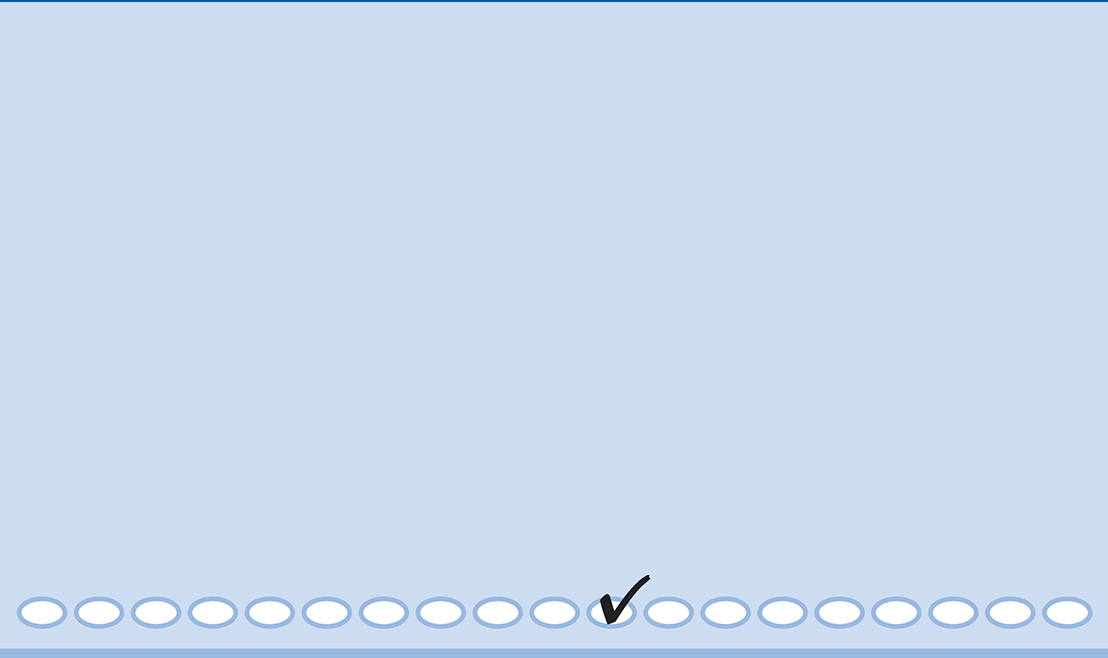
ANSWER SHEET for PRACTICE TEST 1
Use a No. 2 pencil and fill in the entire circle darkly and completely. If you change your response, erase as completely as possible


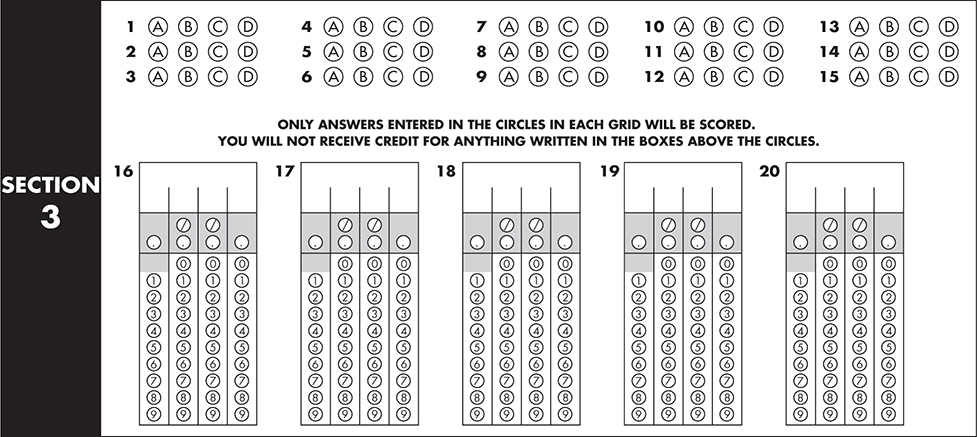
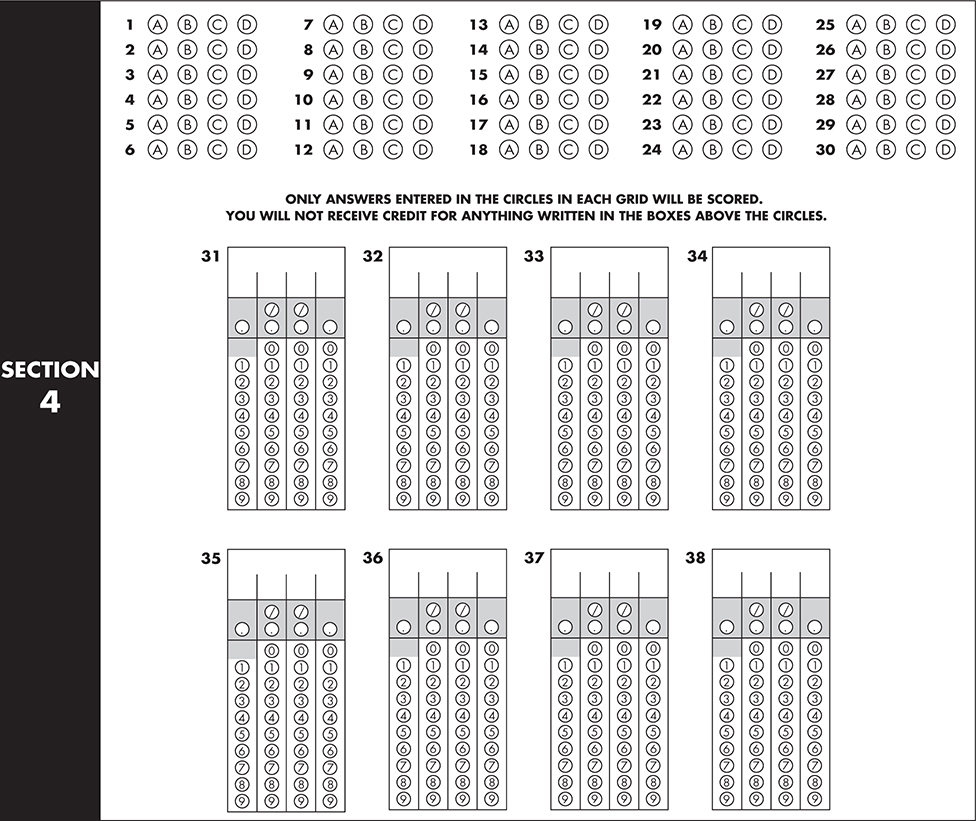
SECTION 5: ESSAY
PLANNING PAGE You may plan your essay in the unlined planning space below, but use only the lined pages following this one to write your essay. Any work on this planning page will not be scored.

BEGIN YOUR ESSAY HERE

DO NOT WRITE OUTSIDE OF THE BOX.

DO NOT WRITE OUTSIDE OF THE BOX.
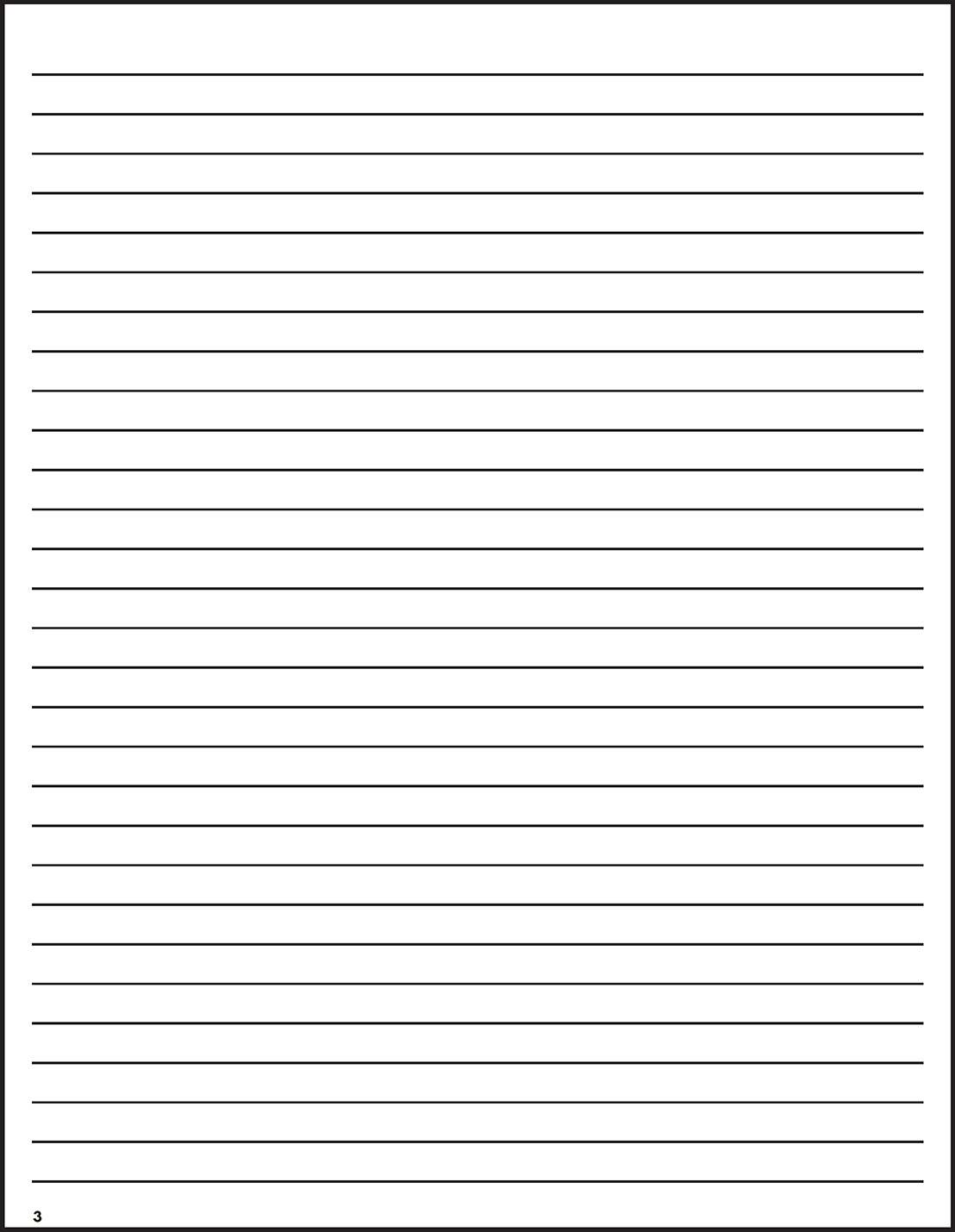
DO NOT WRITE OUTSIDE OF THE BOX.

Test begins on the next page.

Reading Test
65 MINUTES, 52 QUESTIONS
Turn to Section 1 of your answer sheet to answer the questions in this section.
DIRECTIONS
Each passage or pair of passages below is followed by a number of questions. After reading each passage or pair, choose the best answer to each question based on what is stated or implied in the passage or passages and in any accompanying graphics.
Questions 1–12 are based on the following passage and supplementary material.
Passage 1 is adapted from Nicholas Heidorn, “The Enduring Political Illusion of Farm Subsidies.” ©2004 The Independent Institute. Originally Published August 18, 2004 in the San Francisco Chronicle. Passage 2 is ©2015 by Mark Anestis. Since 1922, the U.S. government has subsidized the agricultural industry by supporting the price of crops (commodity subsidies), paying farmers let their fields go fallow (conservation subsidies), helping farmers purchase crop insurance (crop insurance subsidies), and compensating farmers for uninsured losses due to disasters (disaster subsidies). The following passages discuss these programs.
Passage 1
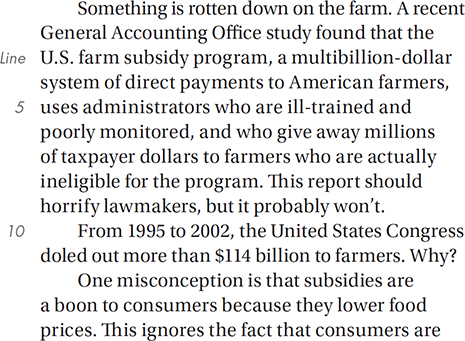
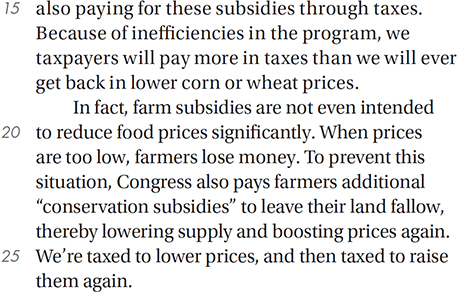
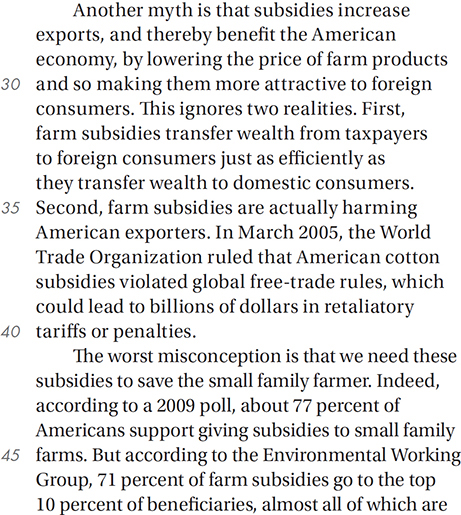
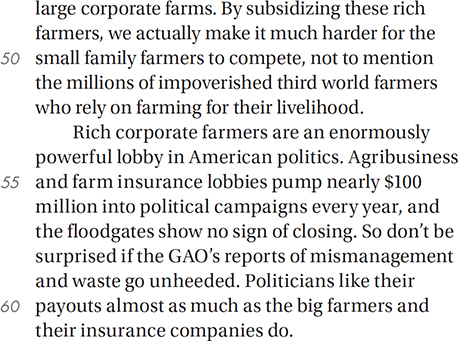
Passage 2
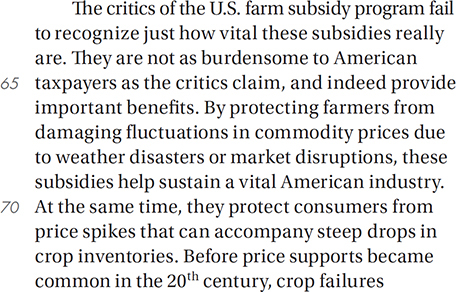
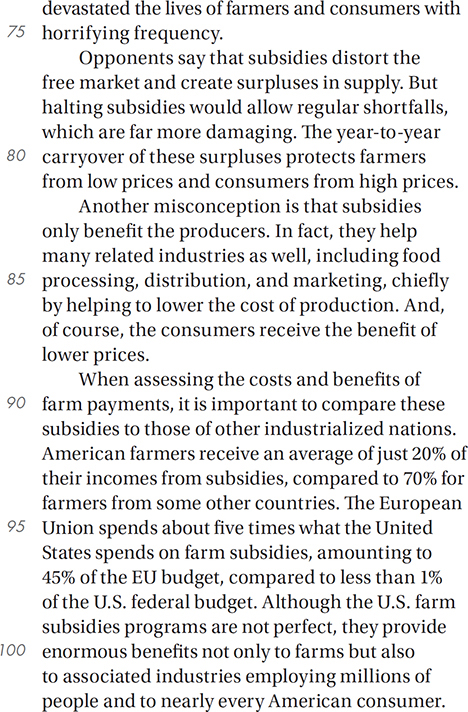
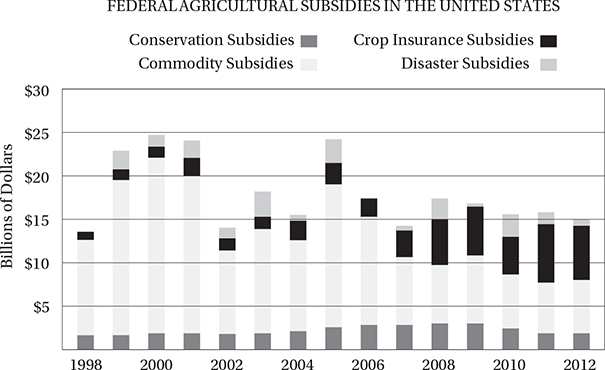
Source: From Environmental Working Group (farm.ewg.org)
Both passages acknowledge the effectiveness of U.S. farm subsidies in
A) stabilizing commodity prices.
B) expanding American exports.
C) assisting smaller farms.
D) increasing agricultural productivity.
The first sentence of Passage 1 refers primarily to the author’s belief that
A) the American government is not doing enough to help small farmers.
B) some American farmers are violating the law.
C) a federal agricultural program is unfair and ineffective.
D) American farmers are struggling to compete in international markets.
The author of Passage 2 would most likely regard the “taxes” mentioned in line 15 as
A) a worthwhile expenditure.
B) a misplaced priority.
C) a political delusion.
D) a technical misnomer.
The author of Passage 1 believes that the GAO report “probably won’t” (line 9) horrify lawmakers because
A) the report indicates that farm subsidies are not as harmful as many suggest.
B) most members of congress do not live in districts that receive farm subsidies.
C) the legislature is too divided along ideological party lines.
D) many members of congress receive benefits from pro-subsidy farm lobbies.
Which of the following provides the strongest evidence for the answer to the previous question?
A) Lines 16–18 (“Because of … wheat prices”)
B) Lines 21–24 (“To prevent this … prices again”)
C) Lines 42–45 (“Indeed … family farms”)
D) Lines 54–57 (“Agribusiness … sign of closing”)
Unlike Passage 1, Passage 2 emphasizes the danger of
A) corrupt political officials.
B) sudden changes in commodity prices.
C) competition in international markets.
D) onerous public tax burdens.
Passage 1 mentions the results of the 2009 poll (lines 42–45) primarily to
A) confirm a general sentiment.
B) refute a misconception.
C) change the focus of the discussion.
D) reveal a surprising finding.
If the author of Passage 1 were to use the data in the graph to support his main thesis, he would most likely mention
A) the general decline in total farm subsidies from 2005 to 2012.
B) the overall rate of change in commodity subsidies from 1998 to 2012.
C) the expansion of crop insurance subsidies from the late 1990s to the late 2000s.
D) the sudden spike in disaster subsidies from 2004 to 2005.
If the author of Passage 2 were to use the data in the graph to support his main thesis, he would most likely mention
A) the general decline in total farm subsidies from 2005 to 2012.
B) the overall rate of change in commodity subsidies from 1998 to 2012.
C) the expansion of crop insurance subsidies from the late 1990s to the late 2000s.
D) the sudden spike in disaster subsidies from 2004 to 2005.
The author of Passage 1 would most likely say that the “benefit” in line 87 is
A) offset by its costs.
B) an exception to a rule.
C) enjoyed only by the wealthy.
D) misrepresented by legislators.
Unlike Passage 2, Passage 1 makes a direct appeal to the reader’s
A) sense of humor.
B) distaste for ineptitude.
C) environmental responsibility.
D) fiscal prudence.
In line 57, the “floodgates” are controls against
A) environmental destruction.
B) unscrupulous funding.
C) emotional outbursts.
D) necessary capital.
Questions 13–22 are based on the following passage.
This passage is adapted from Marie Myung-Ok Lee, Somebody’s Daughter. ©2006 Beacon Press. The story is about a Korean-American girl adopted by an American family and raised in the Midwest.
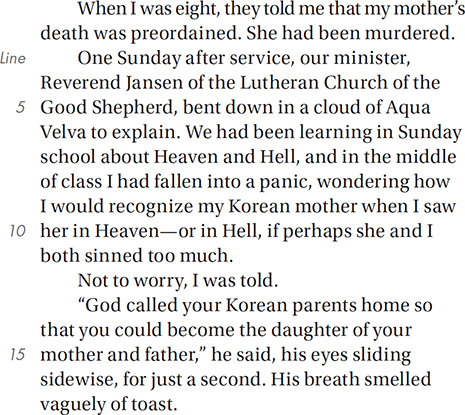
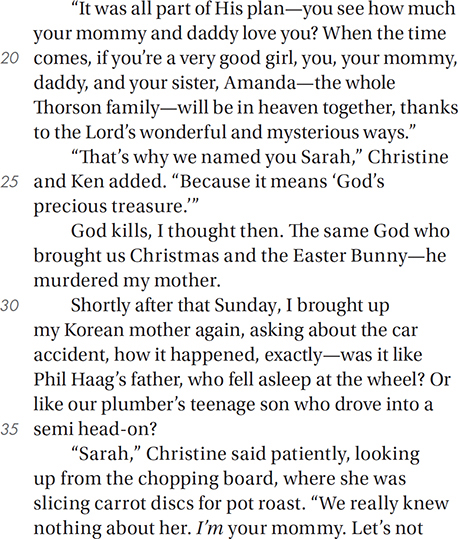
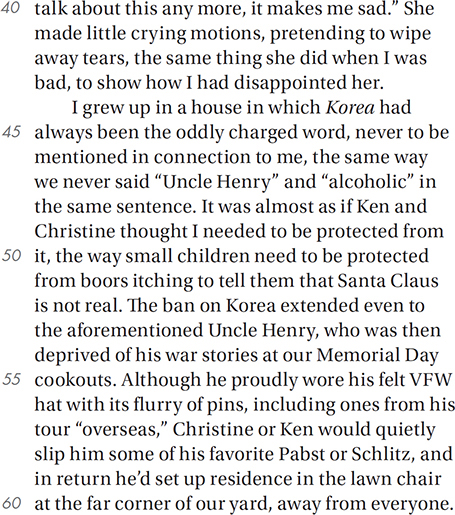
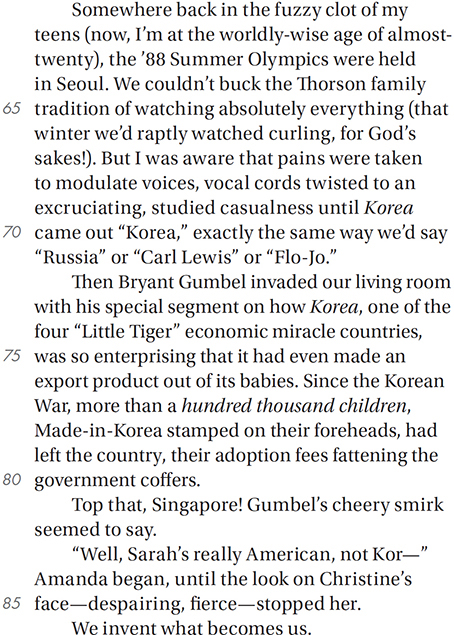
The narrator characterizes Reverend Jansen primarily as
A) an aloof scholar.
B) a fierce taskmaster.
C) a sympathetic caregiver.
D) a patronizing figure.
The narrator’s statement that her mother “had been murdered” (line 2) is best taken to mean that
A) her mother was killed by a negligent driver.
B) the reputation of her mother had been severely impugned.
C) the death of her mother was deliberate.
D) her adoptive family was trying to obliterate all memory of her biological mother.
The narrator’s description of the reverend’s “eyes” and “breath” in lines 15–16 primarily convey a sense of
A) empathy.
B) detachment.
C) geniality.
D) severity.
Christine believes that Sarah’s ethnicity is
A) a source of pride.
B) an exotic mystery.
C) a sacred blessing.
D) an unfortunate fact.
Which choice provides the best evidence for the answer to the previous question?
A) Lines 13–16 (“God called … second”)
B) Lines 24–26 (“That’s why … treasure”)
C) Lines 48–52 (“It was almost … is not real”)
D) Lines 76–80 (“Since the Korean … government coffers”)
Lines 27–29 (“God kills … my mother”) are striking for their use of
A) juxtaposition.
B) metaphor.
C) personification.
D) understatement.
Lines 36–44 chiefly describe Christine’s
A) cunning deceitfulness.
B) sense of superiority.
C) motherly sympathy.
D) emotional immaturity.
In line 45, “charged” most nearly means
A) loaded.
B) entrusted.
C) attacked.
D) demanded.
The passage suggests that Uncle Henry’s role in the Thorson family is that of
A) a stern patriarch.
B) a bigoted lout.
C) a pitiable embarrassment.
D) a noble hero.
The “cheery smirk” (line 81) is taken by the narrator to indicate Gumbel’s
A) satisfaction with the publicity the Olympics were receiving.
B) admiration for Korea’s economic competitiveness.
C) pleasure that Korean children would be well cared for.
D) happiness that Singapore had finally been defeated.
Questions 23–32 are based on the following passage and supplementary material.
This passage is adapted from G. M. Fitzhenry, “Baby Pictures of the Universe.” ©2015 by College Hill Coaching.
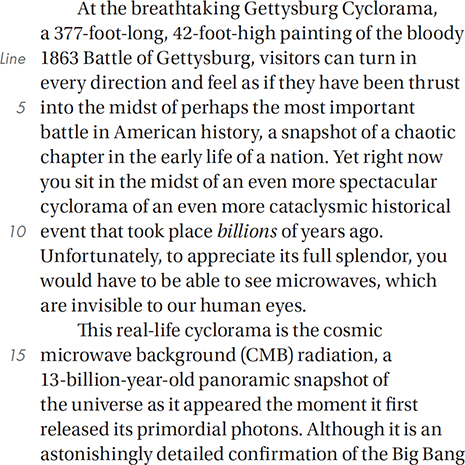
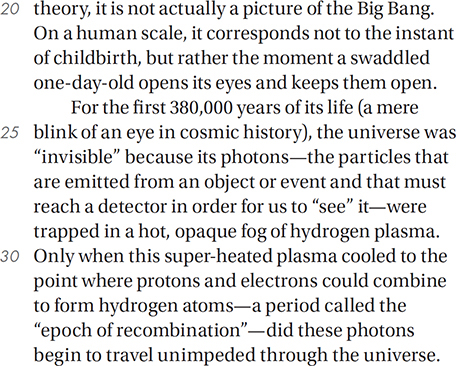
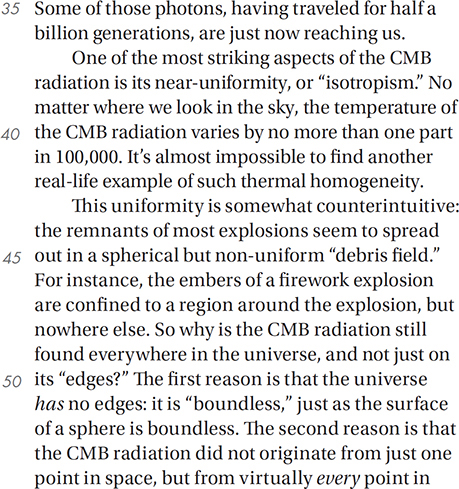
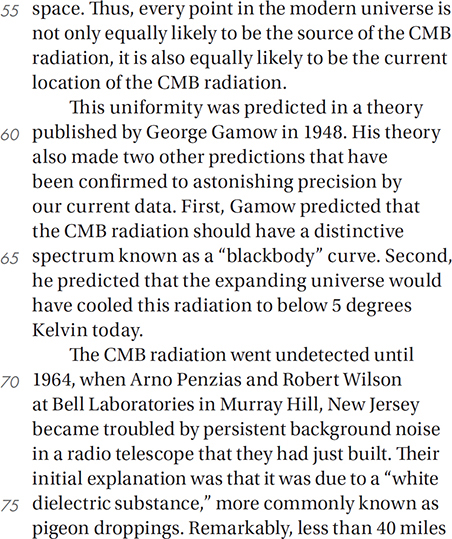
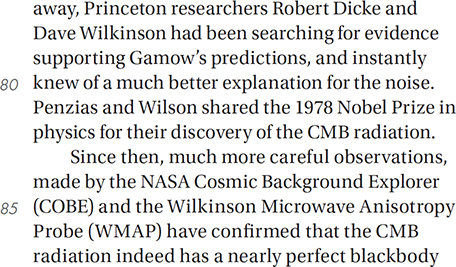
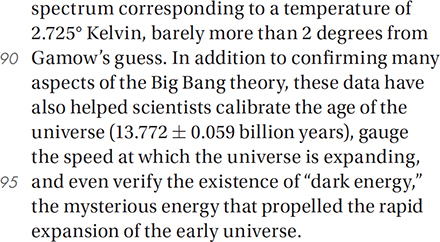
This passage is primarily concerned with
A) chronicling the discoveries yielded by recent satellite telescopes.
B) examining the controversies surrounding a physical theory.
C) discussing the analysis and significance of a cosmological phenomenon.
D) describing similarities between the study of human history and the study of astronomy.
In the context of the passage as a whole, the Gettysburg Cyclorama represents
A) an illustrative analogy.
B) a historical precedent.
C) a quaint anachronism.
D) an accidental success.
Lines 11–13 (“Unfortunately … human eyes”) convey the author’s disappointment in
A) the appropriateness of a comparison.
B) an audience’s level of interest.
C) the magnitude of an event.
D) the accessibility of a phenomenon.
The quotation marks around the words “invisible” (line 26) and “see” (line 28) serve primarily to
A) draw attention to two relatively recent coinages.
B) imply that the author is speaking speculatively.
C) suggest an irony implicit in conventional terms.
D) indicate a technical usage of common words.
The “moment a swaddled one-day-old opens its eyes” (lines 22–23) corresponds to the instant that
A) scientists first discovered the cosmic microwave background radiation.
B) all of the particles and energy in the universe were created in the Big Bang.
C) the cosmic microwave background radiation was first released from the hydrogen plasma.
D) George Gamow first published his theory about the cosmic microwave background radiation.
In line 64, “distinctive” most nearly means
A) bizarre.
B) distinguishing.
C) elite.
D) irreconcilable.
Which of the following can be inferred about the work that earned Penzias and Wilson the Nobel Prize?
A) It was the product of decades of research.
B) It was the result of an accidental discovery.
C) It depended greatly on the data from the COBE satellite.
D) It provided a more plausible alternative to Gamow’s theory.
Which choice provides the best evidence for the answer to the previous question?
A) Lines 60–63 (“His theory … current data”)
B) Lines 73–76 (“Their initial … droppings”)
C) Lines 83–90 (“Since then … Gamow’s guess”)
D) Lines 90–97 (“In addition … early universe”)
Figure 1 best supports which claim made in the passage?
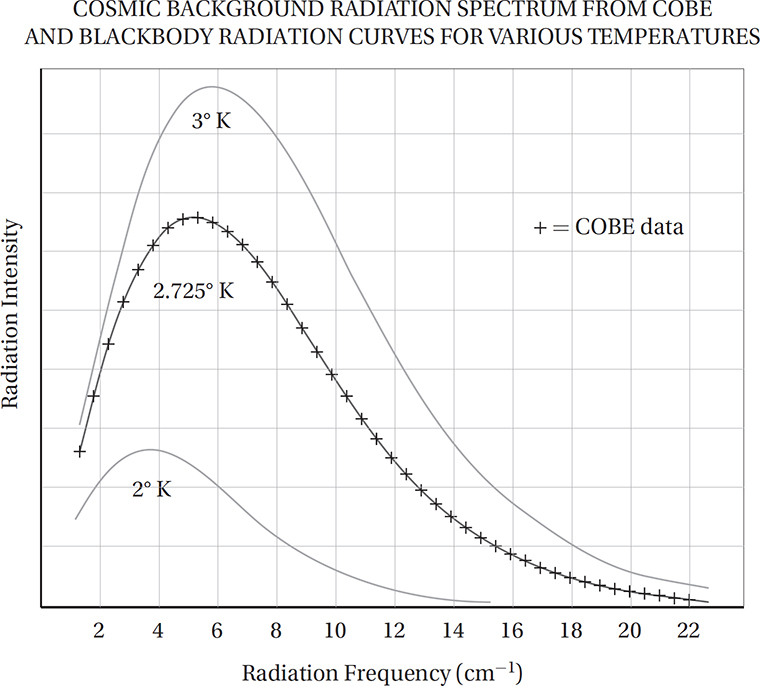
Figure 1. Comparison of COBE radiation data to blackbody curves for 2° K and 3° K
A) “For the first 380,000 years of its life … the universe was ‘invisible’” (lines 24–26)
B) “the CMB radiation did not originate from just one point in space” (lines 53–54)
C) “Their initial explanation was that it was due to a ‘white dielectrical substance’” (lines 73–75)
D) “CMB radiation … has a nearly perfect blackbody spectrum” (lines 86–88)
Figure 2 best supports which claim made in the passage?
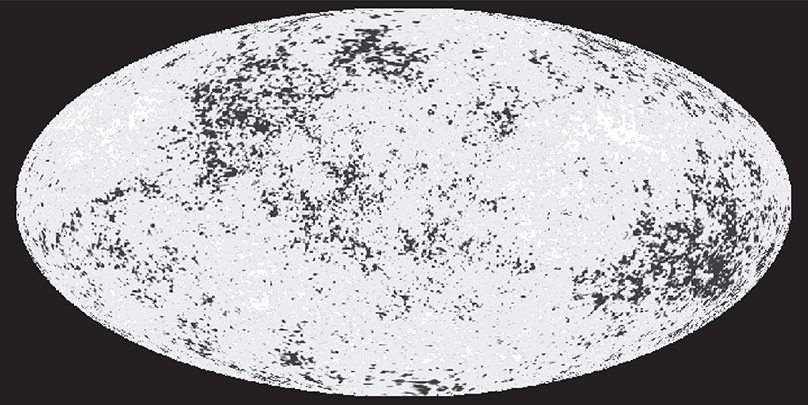
Figure 2. Panoramic map of the cosmic background radiation showing temperatures ranging from 2.7248° K (dark) to 2.7252°; K (white)
A) “For the first 380,000 years of its life … the universe was ‘invisible’” (lines 24–26)
B) “the CMB radiation did not originate from just one point in space” (lines 53–54)
C) “Their initial explanation was that it was due to a ‘white dielectrical substance’” (lines 73–75)
D) “CMB radiation … has a nearly perfect blackbody spectrum” (lines 86–88)
Questions 33–42 are based on the following passage.
This passage is from John Adams, “A Dissertation on Canon and Feudal law.” Originally published in 1765.
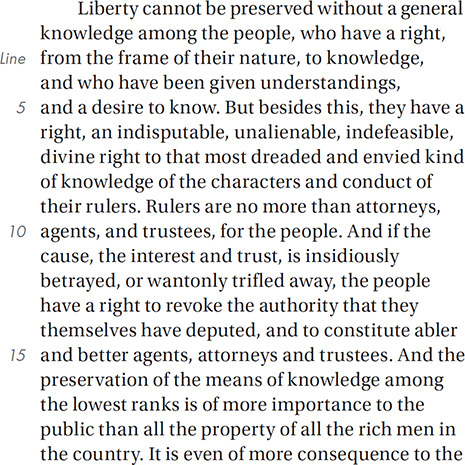
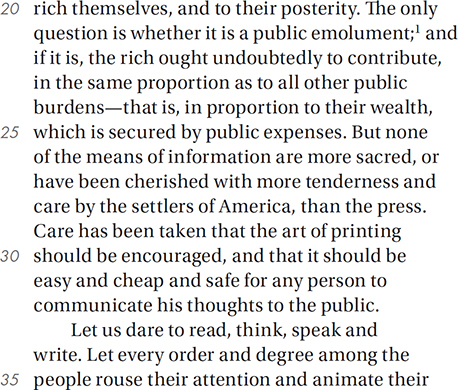
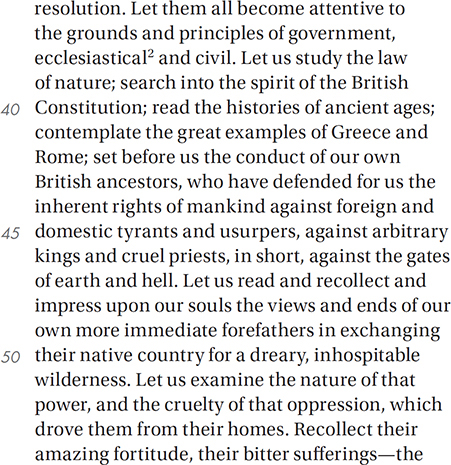
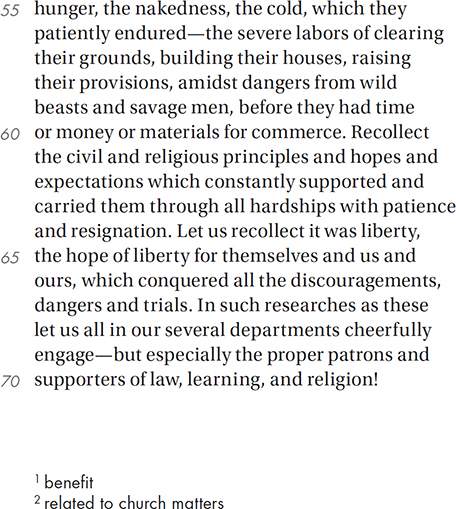
The first paragraph is primarily concerned with the right of citizens to
A) pursue academic interests.
B) learn more about their leaders.
C) become proficient in the art of printing.
D) propose helpful legislation.
In line 14, “constitute” most nearly means
A) place in power.
B) account for.
C) amount to.
D) be regarded as.
The passage indicates that our “forefathers” (line 49) endured all of the following EXCEPT
A) physical deprivation.
B) political oppression.
C) arduous physical labor.
D) a sense of despair.
The passage indicates that all people are born with
A) a curious nature.
B) a desire for power.
C) a dread of tyranny.
D) a sense of thrift.
Which sentence provides the best evidence for the answer to the previous question?
A) Lines 1–5 (“Liberty … to know”)
B) Lines 10–15 (“And if the cause … trustees”)
C) Lines 20–25 (“The only question … public expenses”)
D) Lines 38–47 (“Let us study … earth and hell”)
In line 34, the phrase “every order and degree” refers to
A) an anthology of official declarations.
B) a set of civic responsibilities.
C) the diverse groups within a society.
D) the highest standards of academic achievement.
Compared to the first paragraph, the second paragraph is more
A) prescriptive.
B) despondent.
C) critical.
D) ironic.
In line 52, “power” refers to
A) a personal ability.
B) a social virtue.
C) a despotic agent.
D) a mysterious spirit.
In lines 46–47, “the gates of earth and hell” refer primarily to
A) the privations endured by our forefathers.
B) the superstitions of ancient cultures.
C) the dangers posed by an ignorant populace.
D) the brutality of oppressive leaders.
In the second paragraph, the discussion of the “views and ends” (line 48) of our forefathers primarily serves to
A) remind the reader of the importance of liberty.
B) establish a contrast between the past and the present.
C) emphasize the significance of hard work.
D) draw attention to an unfortunate tradition.
Questions 43–52 are based on the following passage and supplementary material.
This passage is from David Biello, “Can Tiny Plankton Help Reverse Climate Change?” ©2015 by David Biello. Originally published in Aeon (http://aeon.co/) on July 1, 2014.
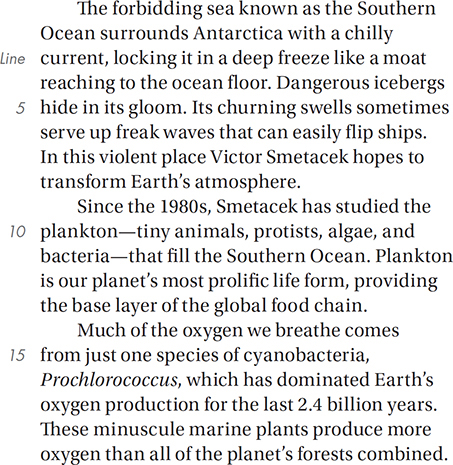
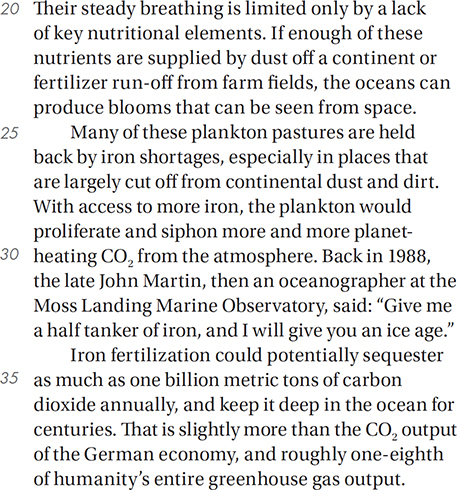
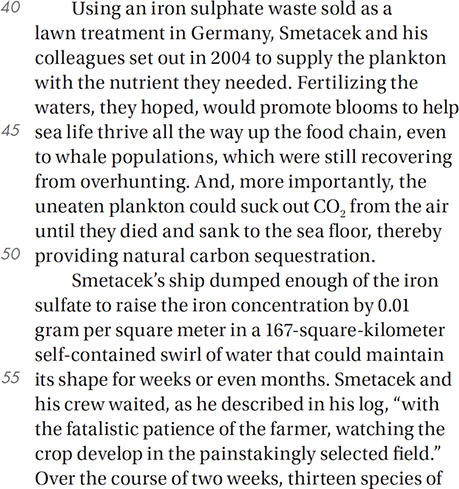
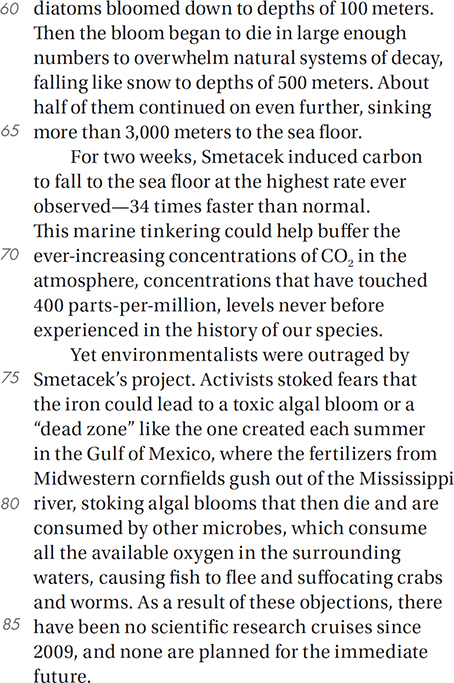
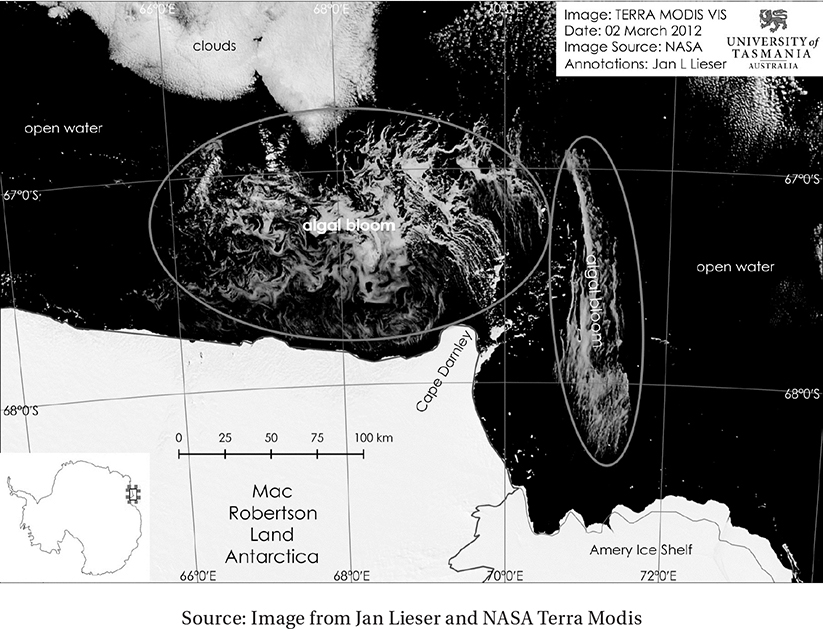
NASA satellite image of the largest recorded natural phytoplankton bloom in February 2012, believed to have been caused by the addition of iron dust blown into the sea around Antarctica by strong offshore winds.
The characterization of the Southern Ocean in the first paragraph (lines 1–8) primarily serves to emphasize
A) the improbability of Smetacek’s success.
B) the pessimism of Smetacek’s detractors.
C) the boldness of Smetacek’s experiment.
D) the promise of Smetacek’s hypothesis.
In line 13, the word “base” most nearly means
A) sordid.
B) precarious.
C) stark.
D) foundational.
The passage indicates that the “fertilizer run-off” (line 23) is
A) an unfortunate by-product.
B) an environmental hazard.
C) a potential sustenance.
D) a source of oxygen.
The author regards the fertilization of oceans with iron as
A) a well-intentioned but environmentally dangerous activity.
B) a brave but needlessly expensive endeavor.
C) a promising and feasible solution to a global problem.
D) an established and valuable component of the worldwide economy.
Which sentence provides the best evidence for the answer to the previous question?
A) Lines 5–6 (“Its churning … ships”)
B) Lines 75–84 (“Activists stoked … crabs and worms”)
C) Lines 90–92 (“Replenishing … the practice”)
D) Lines 94–96 (“Instead, it’s … environment”)
Which of the following statements about Smetacek’s research is best supported by the diagram?
A) The iron fertilization from Smetacek’s experiment created a secondary algal bloom nearly as large as the primary bloom.
B) Smetacek’s experiment would likely have been more successful if it were conducted in February, which is the warmest month in the southern hemisphere.
C) Naturally occurring algal blooms in the Southern Ocean can be more than 30 times as large as the one created in Smetacek’s experiments.
D) Algal blooms are likely to get smaller as they move away from the ice shelves that surround Antarctica.
The passage suggests that Smetacek regarded the death of the alga bloom described in lines 61–65 as
A) vindication of his theory that iron fertilization can lead to carbon sequestration.
B) an indication of the potential dangers of “dead zones” such as those in the Gulf of Mexico.
C) evidence that there was insufficient oxygen in the Southern Ocean to support large blooms.
D) a disappointment because the diatoms were being removed from the food chain.
The passage suggests that iron fertilization could potentially help the whale population primarily by
A) increasing the concentration of oxygen in the ecosphere.
B) decreasing the concentration of carbon dioxide in the atmosphere.
C) supporting an important food source for the whales.
D) reducing the demand for hunting in areas where the whales are endangered.
The “route” mentioned in line 91 refers to
A) an experimental procedure.
B) an economic difficulty.
C) an idealistic approach.
D) a mode of persuasion.
The tone of the final paragraph is best described as
A) sanguine.
B) awestruck.
C) apprehensive.
D) fatalistic.
STOP
If you finish before time is called, you may check your work on this section only. Do not turn to any other section of the test.

Writing and Language Test
35 MINUTES, 44 QUESTIONS
Turn to Section 2 of your answer sheet to answer the questions in this section.
DIRECTIONS
Each passage below is accompanied by a number of questions. For some questions, you will consider how the passage might be revised to improve the expression of ideas. For other questions, you will consider how the passage might be edited to correct errors in sentence structure, usage, or punctuation. A passage or a question may be accompanied by one or more graphics (such as a table or graph) that you will consider as you make revising and editing decisions.
Some questions will direct you to an underlined portion of a passage. Other questions will direct you to a location in a passage or ask you to think about the passage as a whole.
After reading each passage, choose the answer to each question that most effectively improves the quality of writing in the passage or that makes the passage conform to the conventions of Standard Written English. Many questions include a “NO CHANGE” option. Choose that option if you think the best choice is to leave the relevant portion of the passage as it is.
Questions 1–11 are based on the following passage.
The Carrot or the Stick?
Good teachers want their students to do well, but getting students 1 responding is not always easy. Simple suggestion works occasionally, but not often enough. Reasoning sometimes works, too, but explaining the logical nuances of behavioral standards 2 is often time-consuming and too often falls on deaf ears.
A) NO CHANGE
B) to become responsive
C) to respond
D) becoming more responsive
A) NO CHANGE
B) are often time-consuming
C) is consuming time
D) consume time
So the practical question becomes: the carrot or the stick? It’s not always easy to choose 3 the potential motivator to consider: by punishment or incentive.
Most educators and psychologists agree that, as a teaching tool, 4 to reward is generally better than punishment, but many psychologists also believe that, occasionally, rewards can be as 5 harmful, if not more so, than punishment. The introduction of a reward system, like gold stars on an attendance sheet or extra recess time for good behavior, can change the nature not only of the desired behavior, 6 but also of the student-teacher relationship.
Psychologist Edward Deci conducted a study in which people were given a challenging puzzle to solve. Some subjects were offered money as a reward for solving the puzzle, and others were not.
Afterward, both groups were observed secretly after the researcher left the room. Many of those who had not been paid as a reward for their work continued to play with the puzzle, presumably because they found it interesting for its own sake. 7 Those who had received the cash rewards, however, showed significantly less interest in returning to the puzzle.
A) NO CHANGE
B) between punishment and incentive when considering potential motivators
C) the potential motivator to consider: either punishment or incentive
D) between punishment and incentive as potential motivators to be considered
A) NO CHANGE
B) reward
C) rewarding
D) a reward
A) NO CHANGE
B) harmful as, if not more harmful than,
C) harmful, if not more harmful, than
D) equally harmful, if not more harmful than,
A) NO CHANGE
B) but also the nature of the student-teacher relationship
C) but the student-teacher relationship as well
D) but the nature of the student-teacher relationship is changed as well
The author is considering deleting the final sentence to make the paragraph more concise. Should the author make this change?
A) Yes, because it conveys information that is already implied elsewhere in the paragraph.
B) Yes, because it conveys information that distracts from the discussion of student motivation.
C) No, because it explains why the experiment was so difficult to conduct.
D) No, because it provides information that is essential to this discussion of student motivation.
8 Interpreting these results, the subjects who were paid probably construed the task as being manipulative: the experimenter was trying to get them to do something through bribery. The unpaid subjects, however, could engage the puzzle on their own terms simply because it was fun.
This study and others like it have profound 9 implications for the classroom. Several experiments have demonstrated that “pay-to-read” programs, where students are given money or gift credits to read books, have surprisingly negative effects on literacy. Such programs do get students to “read” more books, but the kind of reading they do is not ideal. Students tend to read superficially and only to get the reward. In follow-up studies, these students show not only lower reading skills but also less desire to read. 10 Nevertheless, the reward system turns reading from a fun activity into drudgery. Students think, if reading is such a rewarding experience, why do they need to pay us to do it?
It would be a mistake to conclude from a few experiments that all rewards are bad. Certainly, honest praise from a respectful teacher can do a great deal to encourage not only good behavior but also intellectual curiosity. Teachers must be aware of their students’ need to feel independent and in control. 11
A) NO CHANGE
B) While interpreting these results
C) One interpretation of these results is that
D) In interpreting these results,
A) NO CHANGE
B) indications
C) improvisations
D) instigations
A) NO CHANGE
B) Evidently
C) However
D) Lastly
The final paragraph is notable primarily for its use of which two rhetorical devices?
A) prescription and qualification
B) illustration and quantification
C) anecdote and metaphor
D) irony and humor
Questions 12–22 are based on the following passage.
The Promise of Bio-Informatics
Although scientists have always been interested in data, modern biologists are increasingly becoming “information scientists.” Biological information science is the study of how chemical signals govern life processes. The most familiar biomolecular code is of course DNA, 12 serving as the chemical compound for the blueprint of life. Another biochemical code tells a fertilized egg how to differentiate into scores of unique cell types—heart, muscle, bone, nerve, gland, 13 blood—that assemble themselves into organs, which in turn assemble themselves into a complex organism.
A) NO CHANGE
B) this is the chemical compound serving as
C) the chemical compound that serves as
D) which is the chemical compound that is serving as
A) NO CHANGE
B) blood, that assemble themselves
C) blood; assembling themselves
D) blood—assembling itself
Yet another code governs 14 how the immune system “reads” the chemical signatures of invading pathogens and then manufactures specialized attack cells to fight infections.
15 Today we are seeing dramatic progress in all three of these areas of biochemistry. The science of genomics is developing better, cheaper, and faster ways to decode our DNA, and doctors are becoming more 16 apropos at using this information to create “personalized medicine.” Other researchers are learning how to turn the most rudimentary human cells, “stem cells,” into specialized tissues 17 for helping to repair damaged human organs. And oncologists—cancer specialists—are now coming to understand how the human immune system can be decoded to provide a crucial weapon against the most dangerous tumors.
Which of the following would not be an acceptable replacement for the underlined phrase?
A) NO CHANGE
B) the way of the immune system
C) the way the immune system
D) the way that the immune system
A) NO CHANGE
B) Therefore,
C) Nevertheless,
D) Ironically,
A) NO CHANGE
B) adept
C) liable
D) essential
A) NO CHANGE
B) in helping repair of
C) in order to help repairing
D) to help repair
18 In particular, the success of these new biological technologies 19 depends on our ability in translating vast quantities of chemical information into digital form. Specialized software and hardware 20 is needed to be developed to turn biochemical data into information that doctors and researchers can use to streamline research and make patients’ lives better. Fortunately, the progress has so far been good. Since the Human Genome Project was completed in 2003, the National Human Genome Research Institute has monitored the cost of decoding a single human-sized genome. A famous law in computer science, known as “Moore’s Law,” says that the cost of processing a given quantity of information should decline by 50% every two years or so. In fact, with “second generation” sequencing techniques developed in 2008, 21 far more people have been able to take advantage of genome decoding.
Which choice most effectively establishes the main topic of the paragraph?
A) Some scientists are skeptical about the viability of such radical new therapies.
B) Researchers from all over the world are collaborating in these new discoveries.
C) These new therapies and cures depend heavily on progress in the computer sciences.
D) Many forms of alternative medicine are being combined with traditional therapies to treat a wide range of diseases.
A) NO CHANGE
B) depend on our ability to translate
C) depends on the ability of our translating
D) depends on our ability to translate
A) NO CHANGE
B) must be developed
C) must develop
D) needs developing
Which of the following statements is best supported by the data in the graph?
A) NO CHANGE
B) The cost per genome decoded has dropped well below what Moore’s Law had predicted.
C) The number of genomes decoded has dropped well below what Moore’s Law had predicted.
D) The cost per genome decoded has dropped well below that of most other medical tests.
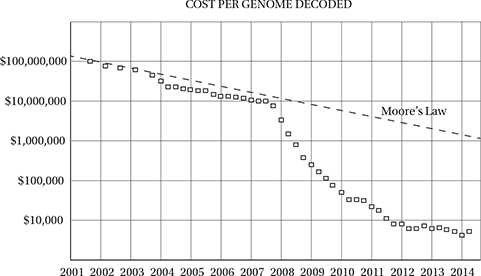
Source: National Human Genome Research Institute: genome.gov/sequencingcosts
This integration of medicine and information technology is perhaps today’s most promising scientific development. Using these new resources, perhaps 22 treatments and even cures for the most intractable diseases can be discovered by researchers.
A) NO CHANGE
B) researchers will discover treatments and even cures for the most intractable diseases
C) treatments and even cures will be discovered by researchers for the most intractable diseases
D) researchers have discovered treatments and even cures for the most intractable diseases
Questions 23–33 are based on the following passage.
What Is Art?
Look around you. Do you see art in your immediate surroundings? What qualities 23 decide that certain things are art? Definitions of art vary widely, but most tend to fall within general notions 24 that have developed over the centuries. The technical ability of an ancient Egyptian potter to produce a well-made clay vessel defined his “art.” In Europe 600 years ago, trade and professional organizations from shoemaking to banking 25 would hold to this broad definition of art as skill in a particular field. The currently popular notion of the artist as the creator and definer of art—put simply, “Art is what artists create”—is a relatively recent one.
Some items and activities in our environment 26 stand out in a conspicuous way as somehow more “art” than others. The way that the visual elements of particular buildings, chairs, album covers, or athletic performances—their line, color, shape, texture, and other visual elements—combine to please the senses, is so satisfying that we call them beautiful. 27
Prior to the twentieth century, most philosophers of art believed that beauty was the defining feature of art. By the turn of the twentieth century, however, some aestheticians had begun to find this definition insufficient. Some said that the defining characteristic of art was the effective expression of 28 emotion; but others said the effective communication of ideas. One influential group, the formalists, argued that an object or activity qualifies as art 29 when its form is sufficiently compelling or inspiring or beautiful to provoke an intense sensory response. This echoed the ancient Greek definition of aesthetic: “of or pertaining to the senses” or “sensuous perception.”
A) NO CHANGE
B) arrange
C) regulate
D) determine
A) NO CHANGE
B) developing
C) which are developed
D) as developed
A) NO CHANGE
B) hold
C) had held
D) held
A) NO CHANGE
B) are conspicuous for how they stand out
C) stand out
D) stand out conspicuously
The end of the second paragraph could be best enhanced with a sentence about
A) an alternate theory of beauty
B) why a particular chair is beautiful
C) how to design more beautiful buildings
D) the benefits of art therapy
A) NO CHANGE
B) emotion; others said it was
C) emotion, others said it was
D) emotion; while others said it was
A) NO CHANGE
B) if its form sufficiently compels
C) if its form is sufficiently compelling
D) if it’s form is sufficiently compelling
Aesthetic experiences are not as rare as you might think. If you have ever felt yourself swept away in the sensuous experience of a sports event, a musical performance, a film, a sunset, or a 30 painting: you have had an aesthetic experience. Look around again. Do any objects in your field of vision provoke an aesthetic experience? 31 Is it skill, beauty, expression, communication, compelling form, or all of the above that make these art for you? Or is it some other quality, such as originality or creativity, 32 that makes these objects or experiences stand out as art?
A) NO CHANGE
B) painting; you
C) painting—you
D) painting, you
A) NO CHANGE
B) Are they
C) Do
D) Are
A) NO CHANGE
B) making these objects or experiences that stand out
C) that make these objects or experiences stand out
D) that stands out in these objects or experiences to make them
Does setting matter? Would a sports photo become more “artistic” if it were placed in an art museum? According to George Dickie’s “institutional theory of art,” major art institutions, such as museums, determine what is art in a given culture. 33
Perhaps art is a concept that cannot have a fixed definition. Perhaps, like a living organism, it must evolve.
Which of the following sentences serves as the most effective concluding sentence for this paragraph?
A) Dickie, a professor emeritus of philosophy at the University of Illinois, has championed the work of philosopher David Hume.
B) Nearly every major city has museums dedicated to the display of works of fine art such as paintings, sculptures, and performance art.
C) Other institutions, such as schools and governments, also provide definitions for concepts like education and public value.
D) This theory forces us to ask: is art truly in the eye of the beholder, or is it in the eye of the artist, the curator, or some critical mass of the consuming public?
Questions 34–44 are based on the following passage.
The Little Tramp
Few people have had as strong an impact on an industry 34 as the impact that Charlie Chaplin had on the world of film. 35 Born in 1889 into an impoverished London family, Chaplin crossed the Atlantic and became a pioneer in silent comedic movies. 36 Early in his film career, Chaplin developed his signature character, the “Little Tramp,” who amused audiences repeatedly with his clever physical comedy and endearing sensitivity. Modest yet clearly intelligent, shy yet always at the center of action, the 37 Tramp’s embodiment was the genius of Chaplin’s artistry.
A) NO CHANGE
B) as what Charlie Chaplin
C) than Charlie Chaplin
D) as Charlie Chaplin
A) NO CHANGE
B) He was born in 1889 into
C) Being born in 1889 into
D) He was born in 1889 of
The author is considering inserting the following sentence at this point in the paragraph.
Charlie’s mother suffered from severe mental illness and was institutionalized for a significant part of Charlie’s young life.
Do you think this is appropriate?
A) Yes, because it helps to explain how Chaplin became a pioneer in film.
B) Yes, because it provides an important detail about health care in 19th-century London.
C) No, because it detracts from the discussion of Chaplin’s impact on the film industry.
D) No, because it diminishes the humorous tone of the paragraph.
A) NO CHANGE
B) genius of Chaplin’s artistry was embodied by the Tramp
C) Tramp embodied the genius of Chaplin’s artistry
D) Tramp’s embodiment was of the genius of Chaplin’s artistry
38 Being writer, director, and editing his own work, Chaplin faced a daunting challenge with the rise of “talkie” films, which drew audiences away from silent stars like the Tramp. Chaplin responded by taking on the additional role of composer, writing beautiful scores to accompany his films and 39 thus allowing the Tramp to remain speechless. Chaplin managed to defy the odds and maintain a remarkable level of popularity and success in the face of technological advancement. 40 Not just a master of the craft of acting and filmmaking, but also the face of a character that resonated deeply with those suffering through the Depression.
A vocal liberal in a time of conservative domination, 41 he became a target for the House Un-American Activities Committee. While he managed to avoid being named to the committee’s Hollywood Ten, a list of black-listed entertainment industry figures suspected of Communist connections, he drew the ire of J. Edgar Hoover 42 in the messages imbedded within his films.
Chaplin saw the dangers in Hitler’s rise to power before most of the world had heard of the dictator. He also believed that the development of the atomic bomb was a crime. Outraged at what 43 they viewed as subversive propaganda created by an immoral man, the United States government 44 eradicated Chaplin’s reentry visa during a trip to London in 1952. Sixty-three years old and tired of fighting against a force unwilling to hear his message, Chaplin agreed to exile rather than going back to America and facing interrogation and lived the rest of his years in Europe. He returned twenty years later to receive an Academy Award for lifetime achievement.
A) NO CHANGE
B) Writing, directing, and being editor of his own work,
C) Writing his own work, as well as directing and editing it too,
D) As the writer, director, and editor of his own work,
A) NO CHANGE
B) therefore he allowed the Tramp to remain
C) allowing the Tramp thus remaining
D) he allowed the Tramp thus to remain
A) NO CHANGE
B) Besides being
C) He was not only
D) In addition to being
A) NO CHANGE
B) the members of the House Un-American Activities Committee targeted him
C) the House Un-American Activities Committee and its members targeted him
D) he became targeted the House Un-American Activities Committee.
A) NO CHANGE
B) by
C) because of
D) from
A) NO CHANGE
B) it
C) would have been
D) were
A) NO CHANGE
B) revoked
C) excluded
D) abolished

Math Test – No Calculator
25 MINUTES, 20 QUESTIONS
Turn to Section 3 of your answer sheet to answer the questions in this section.
DIRECTIONS
For questions 1–15, solve each problem, choose the best answer from the choices provided, and fill in the corresponding circle on your answer sheet. For questions 16–20, solve the problem and enter your answer in the grid on the answer sheet. Please refer to the directions before question 16 on how to enter your answers in the grid. You may use any available space in your test booklet for scratch work.
NOTES
1. The use of a calculator is NOT permitted.
2. All variables and expressions used represent real numbers unless otherwise indicated.
3. Figures provided in this test are drawn to scale unless otherwise indicated.
4. All figures lie in a plane unless otherwise indicated.
5. Unless otherwise indicated, the domain of a given function f is the set of all real numbers for which f(x) is a real number.
REFERENCE
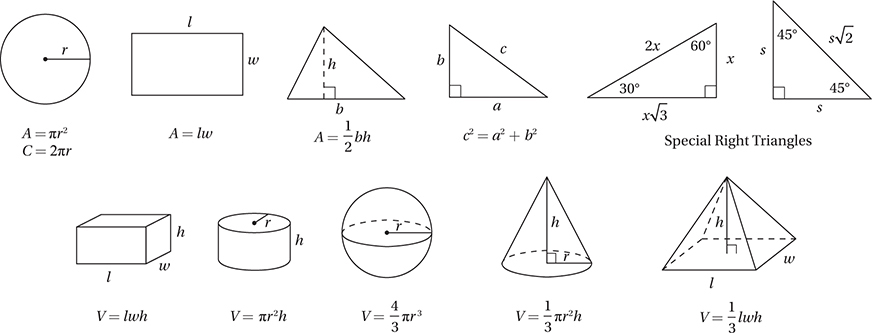
The number of degrees of arc in a circle is 360.
The number of radians of arc in a circle is 2π.
The sum of the measures in degrees of the angles of a triangle is 180.
If 8x + 6 = 6m, what is the value of 4x + 3 in terms of m ?
A) 2m – 3
B) 2m
C) 3m – 3
D) 3m

Which of the following ordered pairs (x, y) is a solution of the system of equations above?
A) (2, 3)
B) (3, 2.25)
C) (4, 1.5)
D) (4, 6)
Which of the following is equivalent to 

If x – 3 is a factor of the expression x2 + kx + 12, what is the value of k ?
A) –7
B) –5
C) 5
D) 7
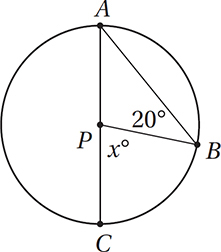
Note: Figure not drawn to scale.
In the figure above, P is the center of a circle and AC is its diameter. What is the value of x ?
A) 60
B) 50
C) 40
D) 30
The nth term of a sequence is given by the expression bn + 4, where b is a positive constant. Which of the following is necessarily equal to b ?
A) the value of the first term
B) the difference between the fourth term and the third term
C) the average (arithmetic mean) of the first three terms
D) the ratio of the second term to the first term
If  , where n > 0, what is the value of m in terms of n ?
, where n > 0, what is the value of m in terms of n ?

One bag of grass seed can cover 5,000 square feet of new lawn. If each bag costs p dollars, which of the following expressions gives the cost, in dollars, to cover a new rectangular lawn that measures a feet by b feet?
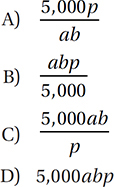
If  , where m > 0, what is the least possible
, where m > 0, what is the least possible
value of m ?
A) 6.5
B) 7
C) 7.5
D) 8
If f (x) = 3x + n, where n is a constant, and f(2) = 0, then f(n) =
A) –24
B) –18
C) –12
D) 12

If s, t, u, and v are the coordinates of the indicated points on the number line above, which of the following is greatest?
A) |s – v|
B) |s – t |
C) |s + v|
D) |u + v|
How many solutions to the equation 4 cos x = 1 lie between x = 0 and x = 3π
A) Two
B) Three
C) Four
D) Six
If  which of the following is NOT equal to i3 + i ?
which of the following is NOT equal to i3 + i ?
A) (2i)2 + 4
B) 2 – 2i4
C) 2i2 – 2
D) i4 – 1
If m > 1, which of the following could be the graph of y = –(x + m)2 + m in the xy-plane?
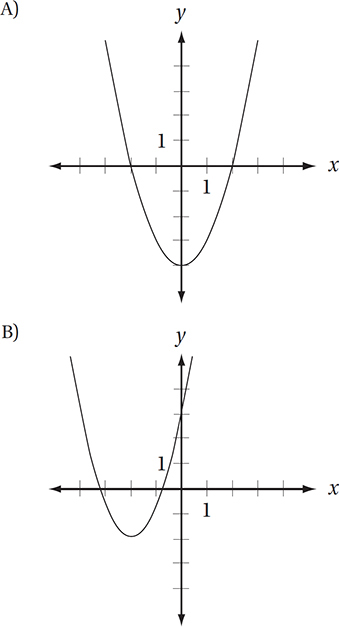
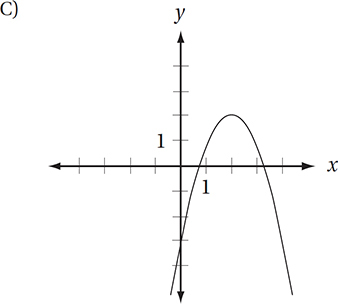
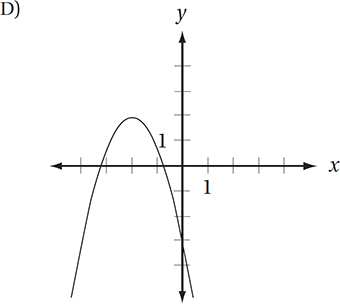

The values of x that satisfy the system of equations above also satisfy which of the following equations?
A) (x – 5)(x + 3) = 0
B) (x – 3)(x + 5) = 0
C) (x – 2)(x – 5) = 0
D) (x + 2)(x + 5) = 0
DIRECTIONS
For questions 16–20, solve the problem and enter your answer in the grid, as described below, on the answer sheet.
1. Although not required, it is suggested that you write your answer in the boxes at the top of the columns to help you fill in the circles accurately. You will receive credit only if the circles are filled in correctly.
2. Mark no more than one circle in any column.
3. No question has a negative answer.
4. Some problems may have more than one correct answer. In such cases, grid only one answer.
5. Mixed numbers such as  must be gridded as
must be gridded as  .
.
(If  is entered into the grid as
is entered into the grid as  , it will be interpreted as
, it will be interpreted as  ).
).
6. Decimal answers: If you obtain a decimal answer with more digits than the grid can accommodate, it may be either rounded or truncated, but it must fill the entire grid.
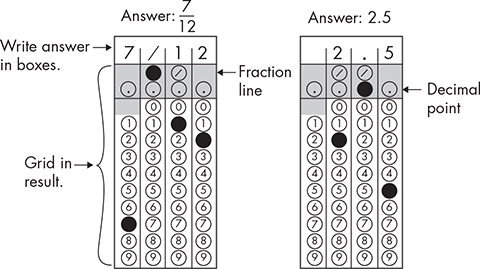
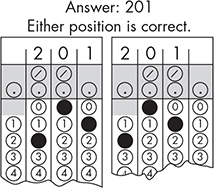
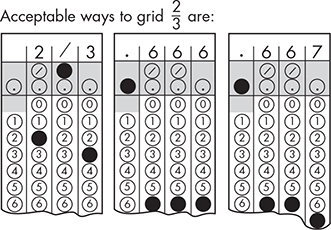
If  , and b = 4, what is the value of a ?
, and b = 4, what is the value of a ?
What is the smallest positive integer value of x such that  is less than 1?
is less than 1?
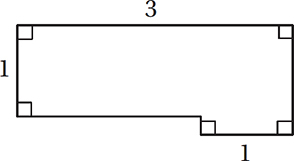
If the area of the figure above is  square units, what is its perimeter?
square units, what is its perimeter?
What is one possible solution to the equation 
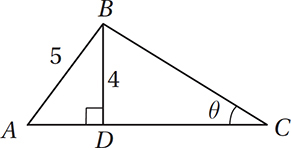
In the figure above, triangle ABC has an area of 19. What is the value of tan θ ?
STOP
If you finish before time is called, you may check your work on this section only. Do not turn to any other section of the test.

Math Test – Calculator
55 MINUTES, 38 QUESTIONS
Turn to Section 4 of your answer sheet to answer the questions in this section.
DIRECTIONS
For questions 1–30, solve each problem, choose the best answer from the choices provided, and fill in the corresponding circle on your answer sheet. For questions 31–38, solve the problem and enter your answer in the grid on the answer sheet. Please refer to the directions before question 31 on how to enter your answers in the grid. You may use any available space in your test booklet for scratch work.
NOTES
1. The use of a calculator is permitted.
2. All variables and expressions used represent real numbers unless otherwise indicated.
3. Figures provided in this test are drawn to scale unless otherwise indicated.
4. All figures lie in a plane unless otherwise indicated.
5. Unless otherwise indicated, the domain of a given function f is the set of all real numbers for which f(x) is a real number.
REFERENCE
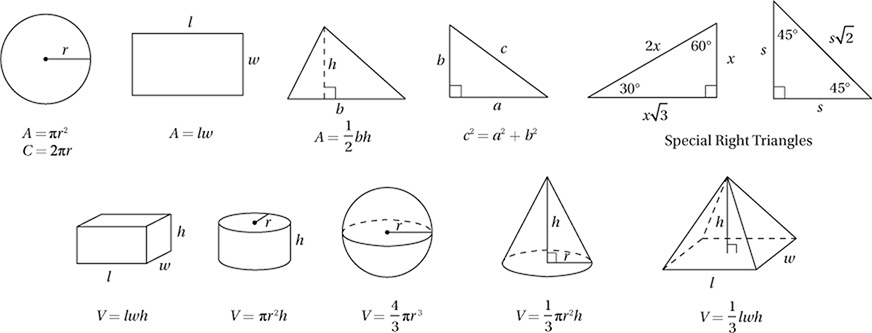
The number of degrees of arc in a circle is 360.
The number of radians of arc in a circle is 2π.
The sum of the measures in degrees of the angles of a triangle is 180.
The fraction  is equal to 0.8. What is the value of n ?
is equal to 0.8. What is the value of n ?
A) 4
B) 8
C) 12
D) 16
The median of the numbers x, 10, and 12 is 12. Which of the following CANNOT be the value of x ?
A) 8
B) 12
C) 16
D) 20
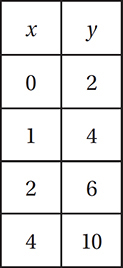
Based on the ordered pairs in the table above, which of the following could express a relationship between x and y ?
A) y = x + 4
B) y = 2x
C) y = 2x + 2
D) y = 2x + 4
The average (arithmetic mean) of a set of 3 positive integers is m. If the number 24 is added to this set, what is the average (arithmetic mean) of the new set of numbers?
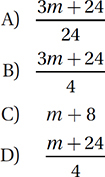
If  what is the value of x ?
what is the value of x ?
A) –3
B) –2

The Municipal Electric Company charges each household $0.15 per kilowatt-hour of electricity plus a flat monthly service fee of $16. If a household uses 30 kilowatt-hours of electricity and is charged $P in a given month, which of the following equations is true?
A) 0.15(30) + 16 = P
B) 0.15P + 16 = 30

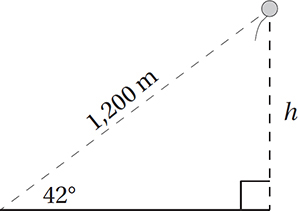
Alyssa determines that a floating balloon is 1,200 meters away from her at an angle of 42° from the ground, as in the figure above. What is the height, h, of the balloon from the ground? (sin 42° = 0.669, cos 42° = 0.743, tan 42° = 0.900)
A) 802.8 meters
B) 891.6 meters
C) 1,080 meters
D) 1,793 meters
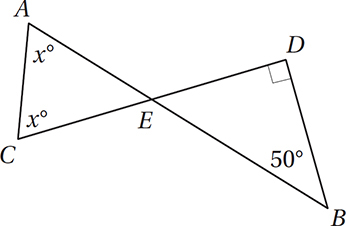
In the figure above, line segments  and
and  intersect at point E. What is the value of x ?
intersect at point E. What is the value of x ?
A) 60°
B) 65°
C) 70°
D) 75°

Questions 9 and 10 are based on the graph below.
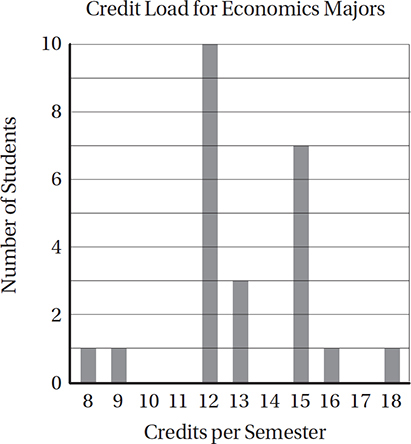
A university surveyed 24 economics majors and asked them how many credits they received the previous semester. The results are represented in the graph above. What percentage of these students received 15 or more credits that semester?
A) 29%

D) 54%
What is the median number of credits these students received the previous semester?
A) 10.5
B) 11.5
C) 12
D) 12.5

If a and b are the coordinates of two points on the number line, then which of the following is equivalent to the statement that the absolute distance from a to b is greater than the absolute distance from –2 to 6 ?
A) |a| > –2 and |b| > 6
B) |a – b| > –8
C) |a + 2| > |b – 6|
D) |a – b| > 8
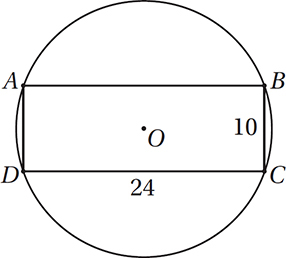
Note: Figure not drawn to scale.
In the figure above, rectangle ABCD is inscribed in the circle with center O. What is the area of the circle?
A) 26π
B) 121π
C) 144π
D) 169π
Everyone in Niko’s class has a different birth date. If Niko is both the 8th oldest person and the 12th youngest person in his class, how many students are in Niko’s class?
A) 18
B) 19
C) 20
D) 21
If  which of the following is equivalent to (2 – i)(3 – 2i) ?
which of the following is equivalent to (2 – i)(3 – 2i) ?
A) 8 – 7i
B) 6 + 2i
C) 6 – 6i
D) 4 – 7i
If f(x) = (x2)-2b and f(3) = 3, what is the value of b ?

In a survey of 80 students, 55 students stated that they play a varsity sport, and 35 stated that they are taking at least one AP level course. Which of the following statements must be true?
A) At least 10 of these students are both playing a varsity sport and taking at least one AP level course.
B) Less than half of the students who play a varsity sport are also taking at least one AP level course.
C) The number of students who do not play a varsity sport is greater than the number of students who do not take at least one AP level course.
D) At least one student who takes an AP level course does NOT play a varsity sport.
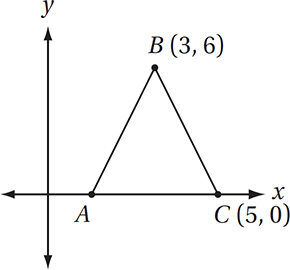
Note: Figure not drawn to scale.
In the figure above, AB = BC. If  has a slope of m and
has a slope of m and  has a slope of n, what is the value of mn ?
has a slope of n, what is the value of mn ?
A) –9

D) 9
The functions f, g, and h are defined by the equations f(x) = x2, g(x) = x, and  . Which of the following must be true?
. Which of the following must be true?
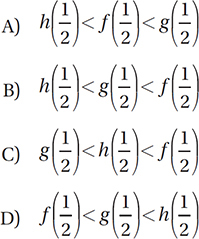
Which of the following scatterplots provides the strongest evidence in support of the hypothesis that y varies inversely as the square of x ?
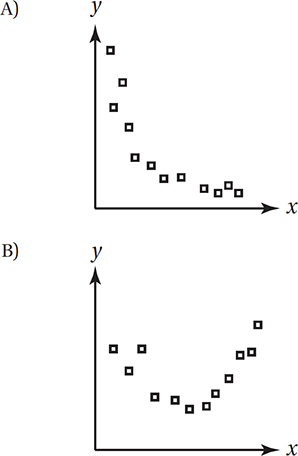
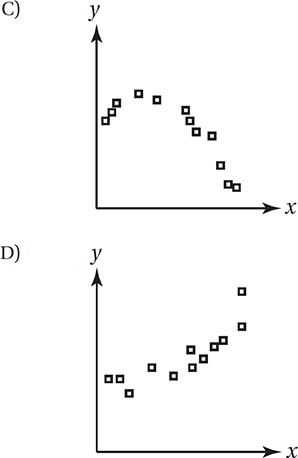
The bird department of a pet store has 12 canaries, 30 finches, and 18 parrots. If the pet store purchased n more finches, then 80% of its birds would be finches. Which of the following equations must be true?
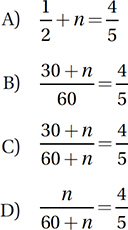
Let function f(x) be defined by the equation f(x) =x2 – 1. If b is a positive real number, then 
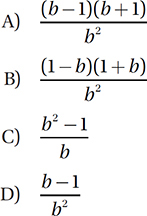
The value of y varies with x according to the equation y = kx2, where k > 0. When the value of x increases from 3 to 12, which of the following best describes the behavior of y ?
A) It increases by 81.
B) It increases by 135.
C) It is multiplied by 4.
D) It is multiplied by 16.
If the function f is defined by the equation f(x) = k(x + 6)(x − 1), where k > 5, then which of the following is equivalent to f(7) ?
A) f(−78)
B) f(−12)
C) f(−2)
D) f(78)
After its initial offering, the price of a stock increased by 20% in the first year, decreased by 25% in the second year, then increased by 10% in the third year. What was the net change in the stock price over the entire three-year period?
A) It increased by 5%.
B) It increased by 1%.
C) It decreased by 1%.
D) It decreased by 5%.
If y = x2, where x ≠ 0, and w = y6, which of the following expresses the value of  in terms of x ?
in terms of x ?
A) x2
B) x4
C) x5
D) x6
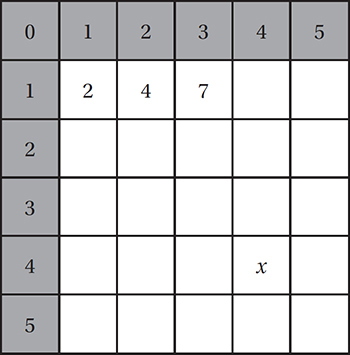
With the exception of the shaded squares in the first row and first column, every square in the table above is to be filled in with a number equal to the sum of the number directly above it and the number directly to its left. For instance, the number 7 in the second row is the sum of 3 in the square above it and 4 in the square directly to its left. What is the value of x ?
A) 16
B) 84
C) 96
D) 112
3x2 = 4x + c
In the equation above, c is a constant. If x = −1 is a solution of this equation, what other value of x satisfies the equation?

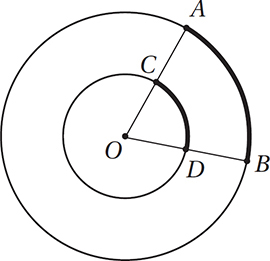
Note: Figure not drawn to scale.
The figure above shows two concentric circles with center O. If OD = 3, DB = 5, and the length of arc AB is 5π, what is the length of arc CD ?


Questions 29 and 30 refer to the following graph.
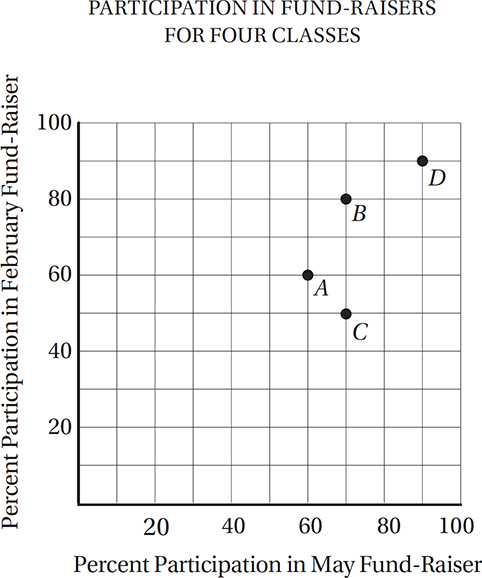
Four different classes at Corbett Elementary School participated in two fund-raisers last year, one in February and another in May. The rates of participation for each class are recorded in the graph above. Which class had the greatest change in percent participation from the February fund-raiser to the May fund-raiser?
A) Class A
B) Class B
C) Class C
D) Class D
If there were 20 students each in Class A and Class C, and 30 students each in Class B and Class D, how many students participated in the May fund-raiser?
A) 71
B) 72
C) 74
D) 76

DIRECTIONS
For questions 31–38, solve the problem and enter your answer in the grid, as described below, on the answer sheet.
1. Although not required, it is suggested that you write your answer in the boxes at the top of the columns to help you fill in the circles accurately. You will receive credit only if the circles are filled in correctly.
2. Mark no more than one circle in any column.
3. No question has a negative answer.
4. Some problems may have more than one correct answer. In such cases, grid only one answer.
5. Mixed numbers such as  must be gridded as
must be gridded as  .
.
(If  is entered into the grid as
is entered into the grid as  , it will be interpreted as
, it will be interpreted as  ).
).
6. Decimal answers: If you obtain a decimal answer with more digits than the grid can accommodate, it may be either rounded or truncated, but it must fill the entire grid.



If  , what is the value of
, what is the value of  ?
?
In the xy-plane, the graph of the equation y = 3x2 – kx – 35 intersects the x-axis at (5, 0). What is the value of k ?
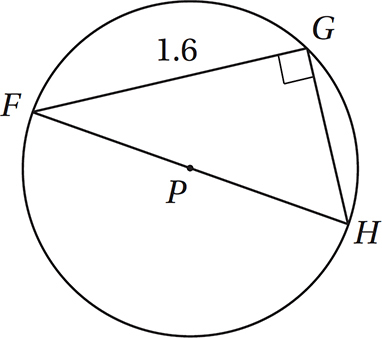
In the figure above, triangle FGH is inscribed in the circle with center P. If the area of the circle is π, what is the area of triangle FGH ?
If  , what is one possible value of 6t ?
, what is one possible value of 6t ?
If cos (x – π) = 0.4, what is the value of sin2 x ?
If one pound of grain can feed either 5 chickens or 2 pigs, then ten pounds of grain can feed 20 chickens and how many pigs?

Questions 37 and 38 are based on the following information
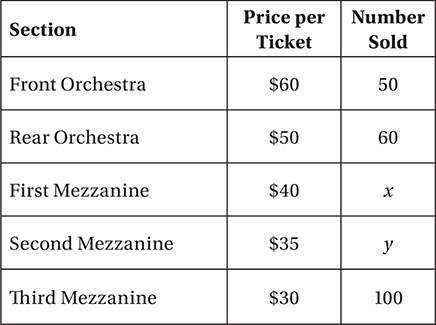
The table above shows information about the tickets sold for a recent performance by a theater troupe. The total revenue in ticket sales for this performance was $15,000.
If 15 more tickets were sold in the second mezzanine than in the first mezzanine, what is the total number of tickets that were sold for this performance?
Before the tickets for this performance went on sale, a consultant for the theater had predicted that n, the number of tickets sold per section, would vary with p, the price in dollars for a ticket in that section, according to the formula  . By how many
. By how many
tickets did this model underestimate the actual total number of tickets sold?

STOP
If you finish before time is called, you may check your work on this section only. Do not turn to any other section of the test.

Essay
50 MINUTES, 1 QUESTION
DIRECTIONS
As you read the passage below, consider how Ellis Parker Butler uses
• evidence, such as facts or examples, to support his claims
• reasoning to develop ideas and connect claims and evidence
• stylistic or persuasive elements, such as word choice or appeals to emotion, to add power to the ideas expressed
Adapted from Ellis Parker Butler, “On Spelling.” Originally published in 1906.
1 My own opinion of the spelling profession is that it has nothing to do with genius, except to kill it. I know that Shakespeare was a promiscuous sort of speller, even as to his own name, and no one can deny that he was a greater genius than Noah Webster. The reason America so long lagged behind Europe in the production of genius is that America, for many decades, was the slave of the spelling-book. No man who devotes the fiery days of his youth to learning to spell has time to be a genius.
2 My wife, Serena, says, and I agree with her, that it is the jealousy of a few college professors who are trying to undermine the younger writers. They know that it is excusable to spell incorrectly now, but they want this new phonetic spelling brought into use so that there shall be no excuse for bad spelling, and that then, Serena says, self-made authors like me, who never can spell but who simply blaze with genius, will be hooted out of the magazines to make room for a stupid sort of literature that is spelled correctly. Serena looks upon the whole thing as a direct, personal stab at me. I look at it more philosophically.
3 To me it seems that the spelling reformers are entirely on the wrong track. Their proposed changes are almost a revolution, and we Americans do not like sudden changes. We like our revolutions to come about gradually. Think how gradually automobiles have come to pass. If, in our horse age, the streets had suddenly been covered with sixty horsepower snorters going thirty miles an hour and smelling like an eighteenth-century literary debate, and killing people right and left, we Americans would have arisen and destroyed every vestige of the automobile. But the automobile came gradually—first the bicycle, then the motorcycle, and so, by stages, to the present monsters. So slowly and progressively did the automobile increase in size and number that it seemed a matter of course. We take to being killed by the automobile quite naturally now.
4 Of course, the silent letters in our words are objectionable. They are lazy letters. We want no idle class in America, whether tramp, aristocrat, or silent letter, but we do not kill the tramp and the aristocrat. We set them to work, or we would like to. My theory of spelling reform is to set the idle letters to work.
5 Take that prime offender, although. Altho does all the work, and ugh sits on the fence and whittles. I would put ugh to work. Ugh is a syllable in itself. I would have the ugh follow the pronounced altho as a third syllable. Doubtless the asthmatic islanders who concocted our English language actually pronounced it so.
6 I propose to have some millionaire endow my plan, and Serena and I will then form a society for the reforming of English pronunciation. I will not punch out the i of any chief, nor shall any one drag me from any programme, however dull. I will pronounce programme as it should be pronounced—programmy—and, as for chief, he shall be pronounced chy-ef.
7 The advantage of this plan is manifest. It is so manifest that I am afraid it will never be adopted.
8 Serena’s plan is, perhaps, less intellectual, but more American. Serena’s plan is to ignore all words that contain superfluous letters. She would simply boycott them. Serena would have people get along with such words as are already phonetically spelled. Why should people write although, when they can write notwithstanding that, and not have a silent letter in it? I have myself often written a phrase twelve words long to stand instead of a single word I did not know how to spell. In fact, I abandoned my Platonic friendship for Serena, and replaced it with ardent love, because I did know how to spell sweetheart, but could not remember whether she was my friend or freind.
Write an essay in which you explain how Ellis Parker Butler builds an argument to persuade his audience that American English spelling conventions of 1906 need to be reformed. In your essay, analyze how Butler uses one or more of the features listed in the box above (or features of your own choice) to strengthen the logic and persuasiveness of his argument. Be sure that your analysis focuses on the most relevant features of the passage. Your essay should NOT explain whether you agree with Butler’s claims, but rather explain how Butler builds an argument to persuade his audience.
SAT PRACTICE TEST 1 ANSWER KEY
Section 1: Reading
1. A
2. C
3. A
4. D
5. D
6. B
7. A
8. C
9. A
10. A
11. B
12. B
13. D
14. C
15. B
16. D
17. C
18. A
19. D
20. A
21. C
22. B
23. C
24. A
25. D
26. D
27. C
28. B
29. B
30. B
31. D
32. B
33. B
34. A
35. D
36. A
37. A
38. C
39. A
40. C
41. D
42. A
43. C
44. D
45. C
46. C
47. D
48. C
49. A
50. C
51. D
52. A
Total Reading Points (Section 1)
Section 2: Writing and Language
1. C
2. A
3. B
4. B
5. B
6. A
7. D
8. C
9. A
10. B
11. A
12. C
13. A
14. B
15. A
16. B
17. D
18. C
19. D
20. B
21. B
22. B
23. D
24. A
25. D
26. C
27. B
28. B
29. C
30. D
31. A
32. A
33. D
34. D
35. A
36. C
37. C
38. D
39. A
40. C
41. A
42. C
43. B
44. B
Total Writing and Language Points (Section 2)
Section 3: Math (No Calculator)
1. D
2. A
3. C
4. A
5. C
6. B
7. A
8. B
9. C
10. A
11. A
12. B
13. C
14. D
15. B
16. 4.5 or 9/2
17. 7
18. 8.4 or 42/5
19. 5 or 7
20. 8/13 or .615
Total Math Points (Section 3)
Section 4: Math (Calculator)
1. D
2. A
3. C
4. B
5. C
6. A
7. A
8. C
9. C
10. D
11. D
12. D
13. B
14. D
15. B
16. A
17. A
18. D
19. A
20. C
21. B
22. D
23. B
24. C
25. D
26. D
27. C
28. B
29. C
30. C
31. 0.8 or 4/5
32. 8
33. .96
34. 4.29 ≤ x ≤ 4.79
35. .84
36. 12
37. 371
38. 25
Total Math Points (Section 4)
SCORE CONVERSION TABLE
Scoring Your Test
1. Use the answer key to mark your responses on each section.
2. Total the number of correct responses for each section:

3. Add the raw scores for sections 3 and 4. This is your Math Raw Score: __________
4. Use the Table 1 to calculate your Scaled Test and Section Scores (10-40).

5. Add the Reading Test Scaled Score and the Writing and Language Test Scaled Score and multiply this sum by 10 to get your Reading and Writing Test Section Score (20-80).

Table 1: Scaled Section and Test Scores (10–40)
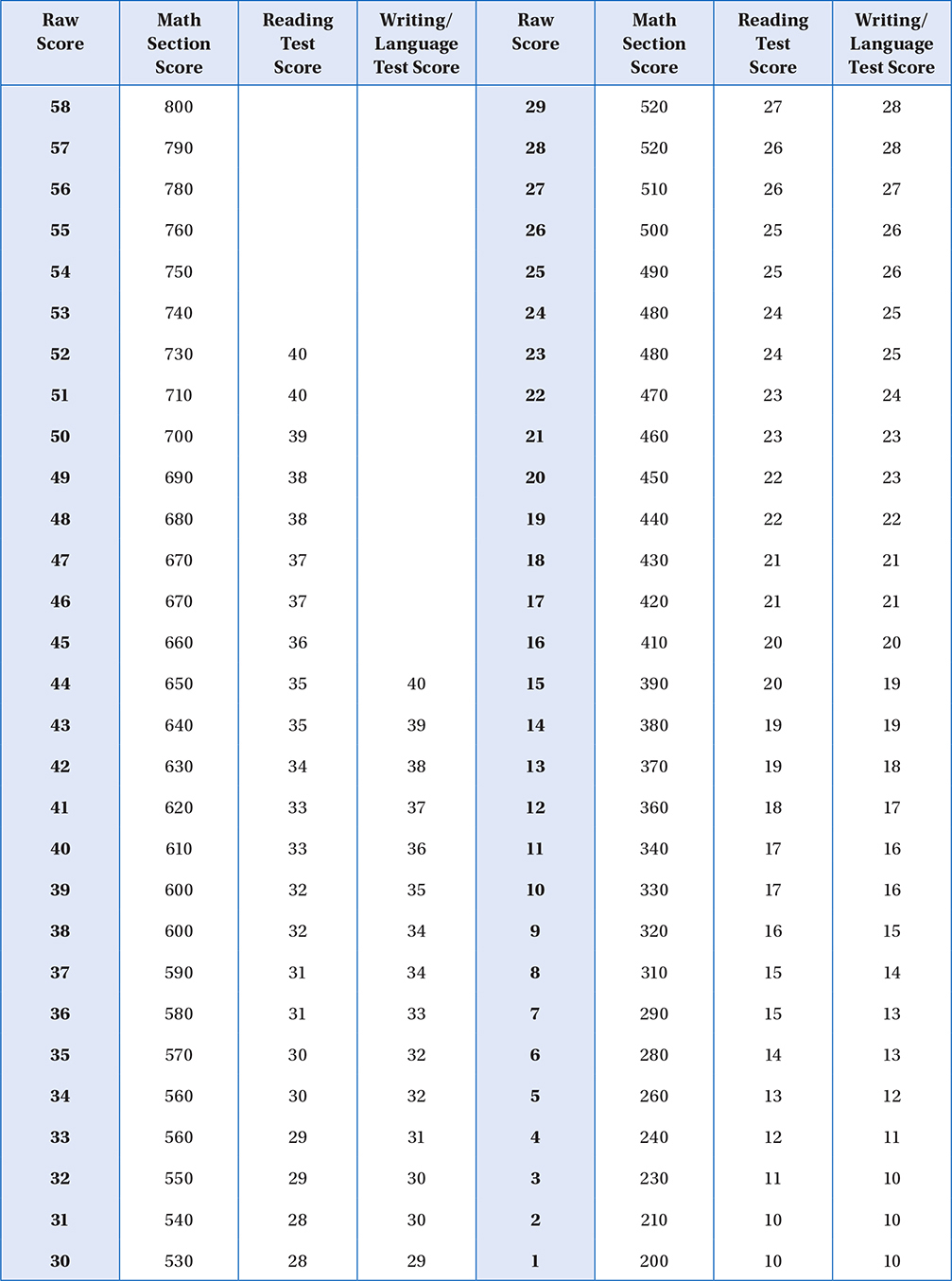
SAT PRACTICE TEST 1 DETAILED ANSWER KEY
Section 1: Reading
1. A
Detail
In lines 10–25, the author of Passage 1 discusses how farm subsidies are used both to lower food prices (by subsidizing farmers) when prices get too high, and to raise them (by paying farmers to leave their land fallow) when prices get too low. Although he disputes that these efforts to stabilize prices are worth the cost, he does indicate that they work. In the first paragraph of Passage 2 (lines 60–73), the author indicates that farm subsidies protect consumers from price spikes (lines 69–70).
2. C
Interpretation
In the first paragraph of Passage 1, the statement that something is rotten down on the farm (line 1) introduces the author’s discussion of the U.S. farm subsidies program, which he claims gives away millions of taxpayer dollars to farmers who are actually ineligible for the program (lines 6–8) and is rife with inefficiencies (line 16).
3. A
Cross-Textual Inference
The thesis of Passage 2 is that U.S. farm subsidies are vital (line 63) to both farmers and American consumers. Therefore, he regards the taxes (line 15) we pay for these subsidies to be a worthwhile expenditure.
4. D
Inference
In lines 8–9, the author of Passage 1 states that the report about corruption and incompetence in the U.S. farm subsidies program should horrify lawmakers, but it probably won’t. He explains why in the last paragraph (lines 53–56): Rich corporate farmers are an enormously powerful lobby in American politics, contributing nearly $100 million into political campaigns every year.
5. D
Textual Evidence
As the explanation to question 4 explains, the evidence for this answer is found in the last paragraph, particularly lines 54–57.
6. B
Passage Comparison
Although the author of Passage 1 does not think that the stabilization of commodity prices is worth the cost of higher taxes (lines 19–25), the author of Passage 2 indicates that price spikes (line 71) can be devastating to both farmers and consumers.
7. A
Specific Purpose
The 2009 poll cited in lines 42–45 indicates that most Americans support farm subsidies for small family farms, confirming the author’s statement that Americans feel that we need these subsidies to save the small family farmer. Choice (B) is incorrect because, although the author himself goes on to refute this misconception, the results of the poll do not. Rather, they confirm a general sentiment. Choice (C) is incorrect because the poll does not indicate any shift away from the discussion about the ineffectiveness of the U.S. farm subsidies program. Choice (D) is incorrect because the word Indeed (line 42) indicates that this result is unsurprising to him.
8. C
Data Analysis
The thesis of Passage 1 is that something is rotten down on the farm (line 1), namely, the fact that, in a recent seven-year period, the Uited States Congress has doled out more than $114 billion to farmers (lines 10–11) through a program that uses administrators who are ill-trained and poorly monitored (lines 5–6) and that implements programs that are not worthwhile to taxpayers, that are actually harming American exporters (lines 35–36) and that make it much harder for the small family farmers to compete (lines 49–50). The graph in Figure 1, however, shows about a 40% decline in these subsidies from 2000 to 2012, perhaps undercutting the author’s claim that these subsidies are an overall burden on the American taxpayer.
He would most likely, then, choose to focus on the component of these subsidies that has grown significantly in the 15 years indicated on this graph, namely, crop insurance subsidies, which have expanded at a fairly steady rate and grew by about 500% from 1998 to 2012. As the introduction to the passage indicates, this program takes money from taxpayers to help farmers to buy crop insurance, thereby providing direct entitlements not only to farmers but also to insurance companies.
Choice (A), the general decline in total farm subsidies from 2005 to 2012, does not help the author make the point that these subsidies are a burden to American taxpayers. Similarly, choice (B), the overall rate of change in commodity subsidies from 1998 to 2012 does not help his thesis, because after the first several years, the trend is generally downward. Choice (D), the sudden spike in disaster subsidies from 2004 to 2005, also does not support his thesis, because he does not make any particular claims about the benefit of disaster subsidies.
9. A
Data Analysis
The thesis of Passage 2 is that farm subsidies in the United States are vital (line 63) and not as burdensome to American taxpayers as the critics claim (lines 64–65). Therefore, the author of Passage 2 would most likely cite evidence that the total cost of the subsidies program is declining.
10. A
Cross-Textual Inference
The author of Passage 1 indicates that we taxpayers will pay more in taxes than we will ever get back in lower corn or wheat prices (lines 16–18), thereby indicating that the benefit of lower prices (lines 87–88) is offset by its costs.
11. B
Cross-Textual Comparison
The author of Passage 1 mentions that the U.S. farm subsidy programs use administrators who give away millions of taxpayer dollars to farmers who are actually ineligible for the program (lines 6–8) and are rife with inefficiencies (line 16) to make the argument that they are not worthwhile to taxpayers. This is an appeal to the reader’s distaste for ineptitude (incompetence).
Although this could also be seen as an appeal to the reader’s fiscal prudence (sense of responsibility), the author of Passage 2 makes the same kind of appeal when he indicates that these subsidies are vital (line 63) to preventing price spikes (line 71) and are not as burdensome to American taxpayers as the critics claim (lines 64–65). Since the question asks us to find an appeal that is NOT also found in Passage 2, choice (D) is incorrect.
12. B
Interpretation
When the author of Passage 1 states that Agribusiness and farm insurance lobbies pump nearly $100 million into political campaigns every year, and the floodgates show no sign of closing (lines 54–57), he suggests that there seem to be no controls against this unscrupulous (unethical) funding of political campaigns by those who benefit from the decisions of those politicians.
13. D
Tone and Characterization
The narrator says that Reverend Jansen bent down in a cloud of Aqua Velva (lines 5–6) and told her not to worry (line 12). He then describes to the narrator why God called [her] Korean parents home (line 13). All of these descriptions work together to portray someone who is acting in a condescending and patronizing manner to a young child.
14. C
Interpretation
The statement that the narrator’s mother had been murdered (line 2) is later explained to refer to the narrator’s interpretation of the fact that she was told that “God called [her] Korean parents home” (line 13) and that “It was all part of His plan” (line 18), in other words, her death was deliberate. At first, choice (D) may seem plausible, because in lines 36–43, Sarah’s mother does not want to talk about Sarah’s biological mother. However, the passage makes it clear that the narrator attributed the “murder” to a divine plan (God kills, I thought then, line 27) rather than to any intention of her adoptive family.
15. B
Tone and Diction
The description of Reverend Jansen’s eyes and breath in lines 13–17 indicates that he is somewhat emotionally detached (his eyes sliding sideways, lines 15–16) and that Sarah is likewise emotionally detached from him and his profound claims, instead distracted by his breath that smelled vaguely of toast (lines 16–17). These descriptions surprise us, because they are so incongruent with the expectation of respect for and contemplation of the reverend’s deep spiritual pronouncements.
16. D
Interpretation
The narrator has Korean heritage, yet she grew up in a house in which Korea had always been the oddly charged word, never to be mentioned in connection with [Sarah], the same way [they] never said “Uncle Henry” and “alcoholic” in the same sentence (lines 44–47). The narrator’s mother, Christine, thought [Sarah] needed to protected from (line 49) her ethnicity. In other words, she regarded Sarah’s ethnicity as an unfortunate fact.
17. C
Textual Evidence
As the explanation to question 16 makes clear, the best evidence for the previous answer is in lines 48–52.
18. A
Literary Device
The contrast between murder and Christmas and the Easter Bunny (line 28) is a classic example of juxtaposition, the act of placing together two images with highly contrasting effects.
19. D
Interpretation
The paragraph states that Christine begins her reply patiently (line 36), which might suggest that she is demonstrating motherly sympathy. However, sympathy means “a feeling of common understanding,” and the rest of Christine’s reply suggests that she is disappointed (line 43) with Sarah rather than sympathetic with her. The point of the paragraph is that Christine is not emotionally ready (it makes me sad, line 40) to discuss something that her eight-year-old adopted daughter clearly wants to discuss, that is, she is emotionally immature.
20. A
Word in Context
When the narrator states that Korea had always been the oddly charged word (lines 44–45), she means that it was a word that was never to be mentioned (lines 45–46), because it was associated with potentially negative feelings. That is, it was an emotionally loaded word.
21. C
Interpretation
In lines 44–60, the narrator describes her Uncle Henry as an “alcoholic” (line 47) who sat drinking at family cookouts at the far corner of our yard, away from everyone (line 60). This is treatment appropriate to a pitiable embarrassment rather than a stern patriarch or noble hero. There is also no indication, despite Sarah’s parents’ discomfort with discussing her heritage, that Uncle Henry is a bigoted lout.
22. B
Tone and Inference
The reference to Bryant Gumbel’s cheery smirk (line 81) follows the description of his television segment during the Olympic games about how Korea had become one of the economic miracle countries (line 74). According to the narrator, the cheery smirk seemed to say Top that, Singapore! thereby indicating that he admired Korea’s ability to compete economically with other strong countries.
23. C
General Purpose
The passage as a whole describes the spectacular cyclorama (line 9) that is known as the cosmic microwave background (CMB) radiation, a 13 billion year-old panoramic snapshot of the universe as it appeared the moment it first released its primordial photons (lines 14–18). It then goes on to discuss the precise measurements that scientists have taken of this radiation and what they tell us about the early universe. In other words, the passage as a whole is discussing the analysis and significance of a cosmological phenomenon.
24. A
Specific Purpose
The description of the Gettysburg Cyclorama in the first paragraph is used to draw an analogy between two cataclysmic historical event[s] (lines 9–10), one of which we can see with our own eyes and one of which we can only detect with special tools. The answer is not (B), because although this Cyclorama depicts a historic battle, it is not itself a historical precedent (an event that serves as a model for future similar events). Choice (C) is incorrect because the painting is depicted neither as quaint nor anachronistic (out of historical order). Choice (D) is incorrect because although the passage later indicates that the discovery of the CMB was somewhat accidental, the Cyclorama was not.
25. D
Interpretation
The author indicates that to appreciate [the] full splendor[of the Cosmic Background Radiation], you would have to be able to see microwaves (lines 11–13). In other words, the disappointment is in the fact that we can’t see the spectacular cyclorama (line 8) that is the cosmic microwave background; it is an inaccessible phenomenon, at least to our naked eyes.
26. D
Specific Purpose
The discussion in lines 24–28 concerns the emergence of the first photons (light particles) in the early universe. In saying that the universe was “invisible” (lines 25–26), the author means that photons—the particles that are required for us to be able to detect something visually—did not yet exist. Calling the early universe “invisible” is somewhat inappropriate, since there were no eyes to see it anyway during that stage in its development, so the quotes are drawing attention to the fact that these terms are being used to make a technical point a bit clearer by using common words that correspond with our everyday experience.
27. C
Interpretation
The moment a swaddled one-day-old opens its eyes (lines 22–23) refers to the moment [the early universe] first released its primordial photons (lines 17–18) which we now refer to as the cosmic microwave background radiation. The discussion in the next paragraph (lines 24–36) explains that these early photons were previously trapped in an opaque fog of hydrogen plasma (line 29). Choices (A) and (D) are incorrect because this moment describes when the photons were released, not when they were first discovered by humans. Choice (B) is incorrect because these particles, as it is explained in the third paragraph, were released 380,000 years after the Big Bang.
28. B
Word in Context
The distinctive spectrum (lines 64–65) refers to the precise “blackbody” curve for 2.75° Kelvin as shown in Figure 1. It is the particular set of wavelength intensities that distinguish blackbody radiation from ordinary radiation, and confirm Gamow’s theory about the origin of the signals detected at Murray Hill.
29. B
Inference
The passage states that Penzias and Wilson were initially troubled (line 72) by the signals that turned out to be from the CMB radiation, and in fact mistakenly attributed them to pigeon droppings (line 76). This indicates that they were not looking for these signals, nor did they know how to interpret them. The work they did to receive the Nobel prize, therefore, was the result of an accidental discovery.
30. B
General Structure
As the explanation of question 29 indicates, lines 73–76 indicate that Penzias and Wilson did not understand the nature of the signals they were receiving, atttributing them erroneously to pigeon droppings.
31. D
Data Analysis
Figure 1 shows the blackbody spectrum for various temperatures, and compares these to the measurements taken of the cosmic microwave background, showing that the CMB radiation has a nearly perfect blackbody spectrum.
32. B
Word in Context
Figure 2 shows a panoramic map of the cosmic background radiation, showing that it did not originate from just one point in space, but rather from every direction.
33. B
General Purpose
The first paragraph states that the people have a right … to that most dreaded and envied kind of knowledge of the characters and conduct of their rulers (lines 5–9). In other words, they have the right to learn about who their leaders are and what they do. Choice (A) is incorrect because the right to pursue academic interests is discussed somewhat in the second paragraph (Let us dare to read, think, speak, and write, line 33) but not in the first. Choice (C) is incorrect, because although Adams says that the art of printing should be encouraged (lines 29–30), this is not the primary point of the paragraph. Rather, it is secondary to the point that citizens should be well informed. Choice (D) is incorrect because although the first passage mentions the right of citizens to revoke the authority (line 13) of their leaders, it does not discuss the right of citizens to propose legislation themselves.
34. A
Word in Context
The statement that the people have a right to revoke the authority that they themselves have deputed, and to constitute abler and better agents, attorneys and trustees (lines 12–15) means that the people have the right to place in power better leaders to replace those whose authority has been revoked.
35. D
Interpretation
The passage indicates that our forefathers endured physical deprivation in the form of the hunger, the nakedness, [and] the cold (line 55), political oppression in the form of domestic tyrants and usurpers (line 45), and arduous physical labor in the form of the severe labors of clearing their grounds, building their houses, [and] raising their provisions (lines 56–58). It does not mention, however, that they endured any feelings of despair. In fact, it says that they endured these with the hopes and expectations which constantly supported and carried them through all hardships with patience and resignation (lines 61–64).
36. A
Interpretation
The very first sentence states that all people have a desire to know (line 5), that is, a curious nature. Choice (B) is incorrect, because although the passage discusses at length the people’s right to revoke the authority of those in power, it does not claim that people themselves have a desire for power. Choice (C) is incorrect, because although the passage discusses the right of the people to revoke the authority of bad rulers, and mentions the inherent rights of mankind against foreign and domestic tyrants and usurpers (lines 44–45), it does not state specifically that the people have any dread of tyranny. Choice (D) is incorrect because the passage does not discuss thrift (resourcefulness with money).
37. A
Textual Evidence
As the explanation to question 36 explains, the best evidence for the previous answer is found in the very first sentence of the passage.
38. C
Interpretation
The phrase every order and degree among the people (line 34) refers to the entire society that Adams is addressing throughout the second paragraph.
39. A
Structural Comparison
The second paragraph is characterized primarily by its use of the imperative mood: Let us dare … Let every order … Let them … Let us study … Let us read … Let us examine … These sentences therefore have a much more urgent and suggestive diction than do the sentences in the first paragraph. While the first paragraph is primarily descriptive of the rights of free citizens, the second is prescriptive of their corresponding duties.
40. C
Interpretation
When Adams says Let us examine the nature of that power (lines 51–52) he is referring to the cruel power that drove [our forefathers] from their homes (line 53), that is, the domestic tyrants (line 45) that made it difficult for them to remain in their native countries. Clearly, then power refers to a despotic (tyrannical) agent.
41. D
Interpretation
Although this paragraph does discuss the privations endured by our forefathers in the form of the hunger, the nakedness, [and]the cold (line 55) and does implicitly warn against the dangerous posed by an ignorant populace because it strongly encourages us to read, think, speak, and write (line 33), this particular sentence is referring specifically to arbitrary kings and cruel priests (lines 45–46). So the phrase the gates of earth and hell (lines 46–47) is referring to the brutality of oppressive leaders who persecute us in our worldly existence and about an otherworldly existence.
42. A
Purpose
The sentence Let us read and recollect and impress upon our souls the views and ends of our own more immediate forefathers in exchanging their native country for a dreary, inhospitable wilderness (lines 47–51) invites us to learn about the beliefs and motivations of our forefathers who came to America to escape oppression. In other words, Adams wants to remind the reader of the importance of liberty.
43. C
Specific Purpose
The first paragraph characterizes the Southern Ocean as a foreboding place by evoking images of its chilly current (lines 2–3), the dangerous icebergs [that] hide in its gloom (lines 4–5), and the churning swells [that] sometimes serve up freak waves that can easily flip ships (lines 5–6). Such images might be used to make a case for the improbability of Smetacek’s success or the pessimism of Smetacek’s detractors, but his portion of the passage contains no such pessimism. Rather goes on directly to explain the promise of Smetacek’s work. This description, therefore, must be regarded as emphasizing the boldness of Smetacek’s experiment.
44. D
Word in Context
The phrase the base layer of the food chain refers to plankton’s role in the global ecosystem, specifically how it serves as the foundation of the food chain.
45. C
Interpretation
Although many environmentalists may well regard fertilizer run-off from farm fields (line 23) as an unfortunate by-product of farming, or an environmental hazard, the author here presents it as supplying some of the key nutritional elements (line 21) for cyanobacteria. Therefore, it is a potential sustenance (nourishment).
46. C
Characterization and Tone
The passage as a whole characterizes Smetacek’s experiments in iron fertilization to promote oceanic cyanobacterial blooms as a demonstration of the potential for large-scale manipulation of the planetary environment (lines 95–96) to remove planet-heating CO2 from the atmosphere (lines 29–30). Therefore, according to the author, this fertilization is a promising and feasible solution to a global problem.
47. D
Textual Evidence
As the explanation to question 46 explains, the best evidence for this answer is found in lines 94–96.
48. C
Data Analysis
Figure 1 depicts a satellite image of the largest recorded natural phytoplankton bloom in February 2012, believed to have been caused by the addition of iron dust blown into the sea around Antarctica by strong offshore winds (from the caption beneath Figure 1). Choice (A) cannot be correct, because Smetacek’s experiment took place in 2004, not 2012. Choice (B) cannot be correct, because the figure does not indicate anything about the relationship between algal bloom size and time of year. Choice (D) cannot be correct, because the figure does not contain any information about the relationship between bloom size and distance from the Antarctic ice shelves. The correct answer is (C) because the figure clearly shows a bloom that is well over 5,000 square kilometers (over 100 km long and over 50 km wide) in area, which is more than 30 times larger than Smetacek’s 167 square kilometer (line 53) bloom.
49. A
Inference
According to the passage, Smetacek’s theory was that iron fertilization of plankton could siphon more and more planet-heating CO2 from the atmosphere (lines 29–30) and then sequester as much as one billion metric tons of carbon dioxide annually, keeping it deep in the ocean for centuries (lines 34–37) by [dying] and [sinking] to the sea floor, thereby providing natural carbon sequestration (lines 49–50). Therefore, the death of the algal bloom described in lines 61–65 is vindication of his theory that iron fertilization can lead to carbon sequestration.
50. C
Inference
The passage states that plankton serves as the base layer of the global food chain (line 13) and therefore fertilizing phytoplankton with iron would promote blooms to help sea life thrive all the way up the food chain, even to whale populations (lines 44–46). Therefore, iron fertilization helps the whale population by supporting an important food source for the whales.
51. D
Interpretation
The second to last paragraph (lines 88–92) discusses a way to motivate further research into iron fertilization (lines 89–90) therefore the route to broader acceptance of the practice (lines 91–92) is a mode of persuasion. Choice (A) is incorrect because, although the research itself probably involves an experimental procedure, the route is not part of the research itself, but rather a means to gain support for that research. Choice (B) is incorrect because, although an appeal to the needs of commerce (line 88) shows an appreciation for economic concerns, the route is not itself an economic difficulty. Choice (C) is incorrect because appealing to the needs of commerce is not an idealistic approach, but rather a pragmatic one.
52. A
Tone
The last paragraph is sanguine (hopeful) about the potential for iron fertilization of the oceans to undo a great deal of the damage we have already done (lines 98–99).
Section 2: Writing and Language
1. C
Idiom
Although gerunds like hiking are often interchangeable with infinitives like to hike (for instance, saying I like hiking is essentially the same as saying I like to hike), often the conventions of idiom dictate a preference for one form over the other in a particular context. In this case, the phrase getting students to respond is proper idiom, whereas getting students responding is not proper idiom. Choice (B) uses an infinitive form, but the phrase to become responsive inappropriately changes the meaning of the sentence.
2. A
Subject-Verb Agreement
The subject-verb core of this clause is explaining … is. Notice that this subject and verb agree in number, whereas choices (B) and (D) would introduce subject-verb disagreement. Choice (C) is not idiomatic, so the original phrasing is best.
3. B
Coordination
The original phrasing misuses the colon, which should be used only to precede an explanatory clause or an explanatory list. Choice (C) is incorrect for the same reason. Choice (D) is incorrect because it commits a number shift: choosing between punishment and incentive is choosing a single motivator, not motivators. Choice (B) avoids these errors and conveys the idea clearly and concisely.
4. B
Parallelism/Logical Comparison
The phrase better than signals that this sentence is making a comparison, which must be both parallel and logical. In the original phrasing, to reward (infinitive) is being compared with punishment (abstract class noun), and since these are different parts of speech, it violates the law of parallelism. The only choice that provides another abstract class noun is (B) reward. Choice (C) is incorrect because rewarding is a gerund, not a class noun, and choice (D) is incorrect because a reward represents an event-instance, not a class of actions.
5. B
Modifier error/Idiom
Remember that any sentence must retain its grammatical integrity even when its modifying phrases are “trimmed” away. The phrase if not more so is an interrupting modifier, but when it is removed, the sentence reads … as harmful … than punishment, which is of course not idiomatic. The only choice that avoids this problem is choice (B).
6. A
Parallelism
This sentence contains the comparative idiom not only A but also B. When we use such idioms, we must make sure that we use the precise phrasing and that the words or phrases that replace A and B are parallel. The original phrasing is both idiomatic and parallel, because both phrases that replace A and B are prepositional phrases. Choice (B) is not parallel, and choices (C) and (D) are neither parallel nor idiomatic.
7. D
Coherence
The passage as a whole is discussing the use of rewards as a teaching tool, so the underlined sentence is important because it indicates their ineffectiveness in that role.
8. C
Dangling Participles
In the original phrasing, as well as in choices (B) and (D), the participle interpreting dangles: its subject does not match the subject of the main clause, subjects. Choice (C) does not have this problem, and conveys the idea clearly and concisely.
9. A
Diction
The original word choice is best. Choice (B) is incorrect because although the results of the study may indicate that changes be made in the classroom, the phrase have profound indications for the classroom is not idiomatic, because indicate is a transitive verb and so requires a direct object. Choice (D) has a similar problem, since the verb instigate is also a transitive verb. Choice (C) is incorrect because improvisations are performances without preparation, which studies cannot do.
10. B
Transitions
This paragraph is discussing the evidence regarding the ability of rewards to incentivize learning. This particular sentence mentions a possible interpretation of that evidence; therefore, the adverb evidently is the most logical sentence modifier. Choices (A) and (C) are incorrect because they inappropriately indicate a contrast. Choice (D) is incorrect because this point is not the last of a sequence of points.
11. A
Rhetorical Devices
The final paragraph contains a prescription (strong suggestion) in the last sentence: Teachers must be aware of their students’ need to feel independent and in control. It also contains a qualification (a statement that moderates a previous claim) in the statement it would be a mistake to conclude that all rewards are bad. Choice (B) is incorrect because the paragraph contains no quantification (numerical measurement). Choice (C) is incorrect because it provides neither anecdote (illustrative story) nor metaphor (comparison that equates to things that are not literally equivalent). Choice (D) is incorrect because the paragraph contains no irony (reversal of reader expectations) or attempts at humor.
12. C
Coordination
The original phrasing is illogical because DNA does not serve as a chemical compound, it is a chemical compound. (Although someone can both serve as a nurse and be a nurse, this is because nursing is a service. Molecules do not perform services in the way that human professionals do.) Choice (B) is incorrect because it produces a comma splice, and choice (D) is incorrect because it is needlessly wordy, and because the present progressive form is serving incorrectly implies a current action rather than a general function. Choice (C) avoids these errors and conveys the idea clearly and effectively in the form of an appositive phrase.
13. A
Punctuation/Pronoun Agreement
Since the sentence uses the em-dash (—) to introduce the list of examples, it must likewise use the em-dash to close this list. Any interrupting phrase must start and end with the same punctuation marks: either commas or em-dashes. Although choice (D) uses the em-dash, it is incorrect because the pronoun itself does not agree in number with the antecedent cell types.
14. B
Diction
Choice (B) includes an illogical use of the preposition of.
15. A
Transitions
The original phrasing is best. Choice (B) is incorrect because the sentence does not indicate any logical consequence. Choice (C) is incorrect because the sentence does not indicate any contrast. Choice (D) is incorrect because the sentence does not indicate any irony.
16. B
Diction
This sentence describes the ability of doctors to use biological information to create “personalized medicine.” One who is particularly skilled is adept. Choice (A) is incorrect because apropos means appropriate to a given situation. Choice (B) is incorrect because liable means likely or legally responsible. Choice (D) is incorrect because the phrase essential at is neither logical nor idiomatic.
17. D
Idiom
This sentence discusses using stem cells to repair damaged organs. The most concise and idiomatic way to express this functional relationship is with the infinitive to help. Choices (A), (B), and (C) all use nonidiomatic phrases.
18. C
Logical Cohesiveness/Transitions
This paragraph discusses the task of translating vast quantities of chemical information into digital form, and indicates that good progress has been made, thanks to progress in specialized hardware and software. Therefore, the best introductory sentence is (C), which focuses on progress in the computer sciences.
19. D
Subject-Verb Agreement/Idiom
The original phrasing is incorrect because the phrase our ability in translating is not idiomatic. Choice (B) is incorrect because the verb depend does not agree in number with the subject success. Choice (C) is incorrect because the phrase the ability of our translating is illogical. Choice (D) avoids these errors and expresses the idea clearly and concisely.
20. B
Idiom/Voice/Mood
The original phrasing is not idiomatic. Choice (C) is incorrect because its use of the active voice is illogical. Choice (D) is also not idiomatic. Only choice (B) conveys the proper mood (necessity) idiomatically and concisely.
21. B
Data Analysis
Choice (A) is incorrect because the graph does not indicate anything about the number of people taking advantage of genome decoding. Choice (B) is correct because the vertical axis of the graph represents the cost per genome decoded, and the data points clearly show that this cost is below the cost predicted by Moore’s Law after 2008. Choice (C) is incorrect because the graph does not indicate anything about the number of genomes decoded. Choice (D) is incorrect because the graph makes no direct comparison of the cost of genome decoding to that of any other medical test.
22. B
Dangling Participles/Verb Tense
The original phrasing is incorrect because the participle using dangles: it does not share its subject with the main clause. Choice (C) is incorrect for the same reason. Choice (D) is incorrect because, although it corrects the dangling participle, the present perfect form of the verb, have discovered, is illogical.
23. D
Diction
The original word choice is illogical since qualities are incapable of deciding anything. Choice (B) and (C) are incorrect for similar reasons: anything that arranges or regulates must have a mind and intention, which qualities lack. Choice (D) is the only reasonable choice, since qualities can determine (that is, play a deciding role in an outcome) whether or not something is art.
24. A
Verb Aspect
The original phrasing is best. The present perfect form have developed is appropriate because the status of the notions is the consequence of how they developed over the centuries. Recall that the perfect (or consequential) aspect is used to indicate a status-as-consequence (see Chapter 4, Lesson 23).
25. D
Verb Tense
This sentence indicates a historical fact, so the simple present tense is best.
26. C
Redundancy
The original phrasing is redundant, since being conspicuous is the same thing as standing out. Choice (C) is the only one that avoids the redundancy.
27. B
Logical Cohesiveness
The paragraph is about the fact that some things in our environment stand out obviously as “art.” It would be reasonable, then, to follow this point with an explanation of why a particular object, such as a chair, qualifies as art.
28. B
Coordination
The original phrasing is incorrect because the clause that follows the semicolon is not independent, and the transitive verb said lacks a logical direct object. Choice (C) is incorrect because it creates a comma splice. Choice (D) is incorrect because the clause that follows the semicolon is not independent. Choice (B) avoids these problems.
29. C
Punctuation/Coordination/Parallelism
The original phrasing is illogical because the adverb when incorrectly implies that whether or not an object qualifies for art is a time-specific event, rather than a general criterion. Choice (B) is incorrect because it creates a non-parallel list: compels … inspiring … beautiful. Choice (D) is incorrect because it’s = it is.
30. D
Coordination/Punctuation
The sentence is a compound sentence joining a dependent clause If you have … and an independent clause you have had… . The original phrasing is incorrect because a colon should be used only to join two independent clauses in which the second explains the first. Choice (B) is incorrect because a semicolon should only be used to join independent clauses. Choice (C) is incorrect because an em dash should only be used to separate an independent clause from an interrupting modifier. Choice (D) is best because a simple comma is most effective at joining a dependent clause and an independent one.
31. A
Verb Form
The original phrasing is best. Choice (B) is incorrect because the pronoun they disagrees in number with its antecedent skill, beauty, or expression. (The conjunction or implies that only one of these serves as the subject; therefore, it is singular.) Choice (C) is incorrect because it does not coordinate with the phrase that gives. Choice (D) is incorrect because it has the disagreement problem of (B) as well as the coordination problem of (C).
32. A
Coordination
The original phrasing is best. Choice (B) is illogical. Choice (C) creates subject-verb disagreement. Choice (D) is awkward and creates an unidiomatic phrase: to make them as art.
33. D
Logical Cohesiveness
This paragraph introduces and defines the “institutional theory of art,” presumably because the author regards it as an interesting theory of aesthetics. Choice (D) is best because it poses an intriguing question that follows directly from that definition. Choices (A), (B), and (C), while true statements, are irrelevant to a discussion of this theory.
34. D
Comparative Idiom/Logical Comparison
This sentence uses the comparative idiom as strong as, so we must check that the comparison is idiomatic, parallel, and logical. The original phrasing and the phrasing in choice (B) are incorrect because they create illogical comparisons: they compare people to an impact. Choice (C) is incorrect because it is not idiomatic. Choice (D) provides an idiomatic, parallel, and logical comparison.
35. A
Coordination/Idiom
The original phrasing of the participial phrase is best: notice that the subject of the past participle born is also the subject of the main clause: Chaplin. Choices (B) and (D) are incorrect because they form comma splices. Choice (C) is incorrect because the present participle being implies that Chaplin was born at the same time that he crossed the Atlantic, which is illogical.
36. C
Logical Cohesiveness
Although this sentence introduces a true and interesting fact, it is inappropriate to this paragraph, which is about Chaplin’s impact on the film industry.
37. C
Coordination
The sentence begins with two adjectival phrases that modify the Tramp. Therefore, these modifiers will dangle unless the subject of the main clause is the Tramp. The only choice that avoids this dangling is (C).
38. D
Parallelism
The original phrasing includes a list that is not parallel: writer, director, and editing. The only choice that does not violate the Law of Parallelism is (D).
39. A
Parallelism
The original phrasing is best because it creates the parallel phrasing taking on … writing … and thus allowing.
40. C
Sentence Fragments/Comparative Idiom
The original phrasing is incorrect because it creates a sentence fragment. Choices (B) and (D) commit the same error. Only choice (D) forms a sentence with an independent clause. Note also that is correctly applies the comparative idiom not only A but also B.
41. A
Dangling Modifiers
The original phrasing is best because it coordinates with the appositive phrase that begins the sentence. Choices (B) and (C) allow this appositive to dangle. Choice (D) is incorrect because the phrase became targeted for is not idiomatic.
42. C
Logical Coordination/Idiom
This sentence describes the reason that Chaplin drew the ire of J. Edgar Hoover. Choice (C) provides the most logical phrase to coordinate this state of being and its cause: because of. The prepositional phrases in the original phrasing and in choices (B) and (D) do not convey this logical relationship.
43. B
Pronoun Agreement
The original phrasing is incorrect because the definite pronoun they disagrees in number with the antecedent government. Choice (C) is incorrect because the subjunctive form would have been incorrectly implies that this clause in counterfactual. Choice (D) is incorrect because propaganda, although it sounds plural, is singular.
44. B
Diction
In this context, eradicated does not work because it means destroy completely, as a scourge, which does not accurately modify a visa. Choice (B), revoked (officially invalidated) works nicely. Choice (C) is illogical because the visa is not disallowed entry into a group, as excluded would imply. Choice (D) is illogical because abolish more properly describes the formal termination of an institution, practice, or system.
Section 3: Math (No Calculator)
1. D
Algebra (solving equations) EASY
8x + 6 = 6m
To solve in one step, just divide both sides by 2:

2. A
Algebra (linear systems) EASY
To determine which ordered pair is a solution to the system, just “plug in” the values for x and y and choose the one that satisfies both equations. Notice that x = 2 and y = 3 is a solution because 3(2) + 4(3) = 18, and  .
.
3. C
Algebra (algebraic expressions) EASY

4. A
Advanced Mathematics (polynomials) EASY
There are several ways to approach this question. Perhaps the simplest is to use the Factor Theorem: If x – c is a factor of a polynomial, then x = c is a zero of that polynomial. Therefore, if x – 3 is a factor of our polynomial, x = 3 must be a zero:

Alternately, you might try to find the other factor of the quadratic. Since the constant term in the quadratic is 12, the constant term in the other binomial factor must be 12 ÷ –3 = –4.

5. C
Additional Topics (circles and triangles) MEDIUM
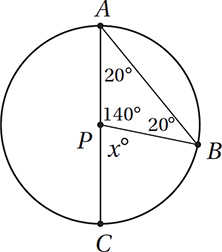
Since PA and PB are both radii of the circle, they are congruent, and so triangle APB is isosceles. By the Isosceles Triangle Theorem, then, angle A must also be 20°. From here, you might simply notice that the angle we’re looking for, CPB, is the external angle to this triangle, and so it has a measure equal to the sum of the two remote interior angles: 20° + 20° = 40°. Alternately, you could notice that angle APB must have a measure of 140° (since all angles in a triangle have a sum of 180°), and since AC is a straight line, angle CPB = 180° – 140° = 40°.
6. B
Advanced Mathematics (sequences) MEDIUM
Let’s choose a value, like b = 2, for our positive constant. This gives us an expression of 2n + 4 for the nth term of the sequence. Substituting n = 1, n = 2, n = 3, etc. gives us a sequence of 6, 8, 10, 12, 14, and so on. Choice (A) is clearly incorrect, because the first term of this sequence is not 2. Choice (C) is also incorrect because the average of the first three terms is (6 + 8 + 10)/3 = 8, not 2. Choice (D) is also incorrect because the ratio of the second term to the first is 8/6 = 4/3. Only choice (B), the difference between the fourth term and the third term, 12 – 10, gives us a value of 2.
7. A
Advanced Mathematics (radical and exponential equations) MEDIUM
For this question, we need to know two Laws of Exponentials from Chapter 9: Law #8 and Law #9. First, we use Law #9 to translate the radicals into exponents.
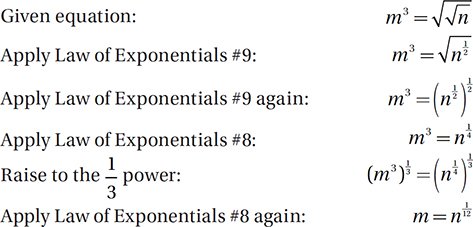
8. B
Algebra (word problems) MEDIUM
Perhaps the most straightforward way to approach this question is to regard it as a conversion from a given area of lawn (in square feet) to cost (in dollars).
Area of rectangular lawn: A = bh = ab square feet Convert using given conversion factors:

Make sure to check this calculation by noticing that all units “cancel” as common factors, except for the unit we want, dollars, which remains in the numerator.
9. C
Advanced Mathematics (rational inequalities) MEDIUM

10. A
Algebra (linear functions) MEDIUM-HARD


11. A
Algebra (absolute values) MEDIUM-HARD
First, we should notice that each choice can be interpreted as a distance between two points on the number line.
(A) |s – v| = the distance between s and v
(B) |s – t| = the distance between s and t
(C) |s + v| = |s – (–v)| = the distance between s and –v
(D) |u + v| = |u – (–v)| = the distance between u and –v
Thinking this way gives us a very straightforward way to solve the problem without doing any calculation. First we need to locate –v on the number line by just reflecting v over the origin at 0. (Recall that multiplication by –1 is equivalent to reflecting a point on the number line over the origin at 0.) This makes it easy to see the distances the problem is asking us to compare:
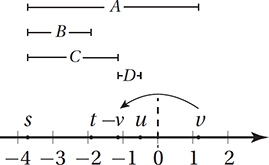
Clearly, the greatest of these distances is (A).
12. B
Special Topics (trigonometry) MEDIUM-HARD
In order to solve this without a calculator, we need to know how to analyze this problem in terms of the unit circle. First, let’s solve for cos x: 4 cos x = 1

What does the mean in terms of the unit circle? Recall from Chapter 10, Lesson 9, that the cosine of any angle corresponds to the x-coordinate of the corresponding point for that angle on the unit circle:
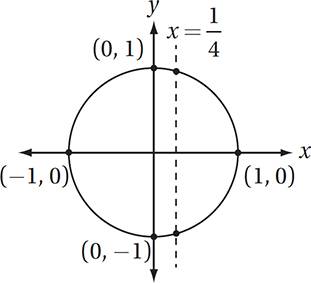
Notice that there are exactly two points on the unit circle that have an x-coordinate of 1/4. Now let’s think about the angle. We are told that x goes from 0 to 3π. Remember that a full trip around the circle is 2π radians; therefore, a journey from x = 0 to x = 3π is 1.5 trips around the circle counterclockwise starting from the positive x-axis. If you trace with your finger 1.5 times around the circle starting from the point (1, 0), you’ll hit our “points of interest” exactly three times.
13. C
Additional Topics (complex numbers) HARD
To solve this without a calculator, you must be able to evaluate a few low powers of i. Recall from Chapter 10, Lesson 10, that i0 = 1, i1 = i, i2 = –1, i3 = –i, and i4 = 1. Therefore i3 + i = –i + i = 0. Now, it’s just a matter of finding the choice that does NOT equal 0.
(A) (2i)2 + 4 = –4 + 4 = 0
(B) 2 – 2i4 = 2 – 2 = 0
(C) 2i2 – 2 = –2 – 2 = –4
(D) i4 – 1 = 1 – 1 = 0
Therefore, the correct answer is (C).
14. D
Algebra (graphs of quadratic equations) HARD
Recall from Chapter 9, Lesson 6, that any equation in the form y = a(x – h)2 + k has a vertex at (h, k) and is open up if a > 0 and down if a < 0. In the equation y = –(x + m)2 + m; therefore, the vertex is (–m, m), and a = –1. Since m > 1, this means that the vertex of the parabola has a negative x-coordinate and a positive y-coordinate, which means the vertex is in quadrant II. And since a < 0, the parabola is open down. The only graph among the choices that is an open down parabola with a vertex in the second quadrant is the graph in choice (D).
15. B
Advanced Mathematics (linear and nonlinear systems) HARD
First, notice that the question is only asking us to find values of x, so it’s a good idea to substitute in order to eliminate y from the system.
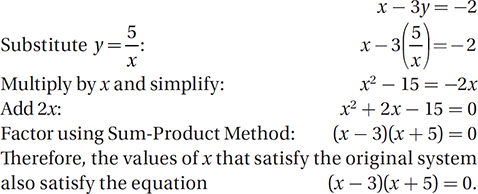
16. 4.5 or 9/2
Algebra (linear equations) EASY


17. 7
Advanced Mathematics (rational equations) EASY

18. 8.4 or 42/5
Additional Topics (perimeters and area) MEDIUM-HARD
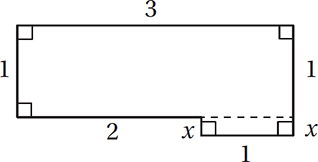
First, drawing a line as shown in the diagram shows that the figure is composed of two rectangles, but the height of the smaller one is unknown. Let’s call it x. The area of the larger rectangle is (3)(1) = 3, and the area of the smaller rectangle is (1)(x) = x. Clearly, the area of the figure must be the sum of these two areas

Therefore, the perimeter of the figure is just the sum of the lengths of its sides. If we travel around the figure clockwise from the leftmost side, we get a perimeter of 
19. 5 or 7 Algebra (rational equations) MEDIUM-HARD

We do this because 4(x + 1)(x – 1) is the least common multiple of the denominators, so multiplying both sides by this will eliminate the denominators and simplify the equation.
Cancel common factors:
24(x –1) – 12(x + 1) = (x + 1)(x – 1)

20. 8/13 or .615
Special Topics (trigonometry) HARD
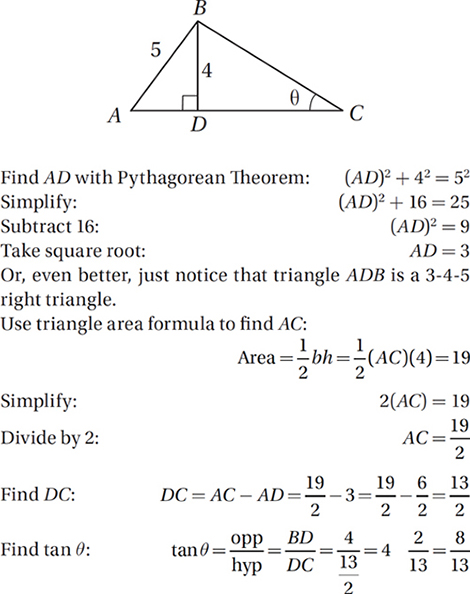
Section 4: Math (Calculator)
1. D
Algebra (solving equations) EASY

Multiply by 20:n = 0.8(20) = 16
2. A
Data Analysis (central tendency) EASY
The median of three numbers is the one in the middle when they are listed in order. If two of the numbers are 10 and 12, with 12 as the median, then the third number must be greater than or equal to 12, otherwise 12 would not be in the middle. Of the choices, only (A) 8 is not greater than or equal to 12.
3. C
Algebra/Data Analysis (expressing relationships) EASY
The first ordered pair, x = 0 and y = 2, does not satisfy the equations in (A), (B), or (D), so those choices can be eliminated. You should also confirm that the equation in (C), y = 2x + 2, is satisfied by all four ordered pairs.
4. B
Data Analysis (central tendency) EASY
Let’s call the 3 positive integers a, b, and c. If the average of these numbers is m, then
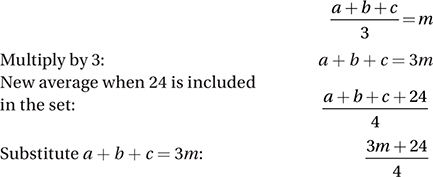
5. C
Algebra (rational equations) EASY

6. A
Algebra (representing quantities) EASY
The cost for a month’s worth of energy is the cost per kilowatt-hour times the total number of kilowatt-hours used: ($0.15/kWh)(30 kWh). The total monthly charge, P, must also include the service fee: P = 0.15(30) + 16.
7. A
Advanced Mathematics (triangle trigonometry) EASY
Remember the definitions of the basic trigonometric functions: SOH CAH TOA. Since the “side of interest” (h) is the opposite side to the given angle (42°), and since we know the length of the hypotenuse (1,200), we should use SOH.
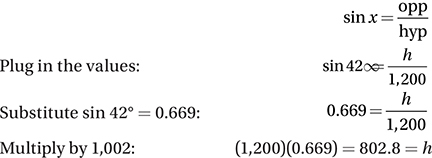
8. C
Special Topics (polygons) EASY
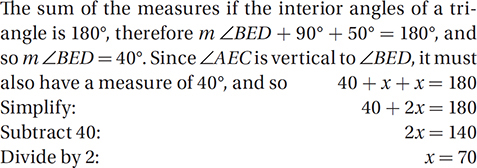
9. C
Data Analysis (histogram) MEDIUM
According to the histogram, 7 students received 15 credits, 1 student received 16 credits, and 1 student received 18 credits, for a total of 9 students who received 15 or more credits. This is 9/24 of the total, or 37.5%
10. D
Data Analysis (histogram/central tendency) MEDIUM
Data set: 8, 9, 12, 12, 12, 12, 12, 12, 12, 12, 12, 12, 13, 13, 13, 15, 15, 15, 15, 15, 15, 15, 16, 18
The median of a set of numbers is the “middle” number of the set when the numbers are listed in order. If the set contains an odd number of numbers, the median is the middle number, but if the set contains an even number of numbers, it is the average of the two middle numbers. Since this set contains 24 numbers, the median is the average or the 12th and the 13th numbers. The 12th number in the set is 12, and the 13th number in the set is 13, the median is 12.5.
11. D
Algebra (absolute values) EASY
The absolute distance from a to b is |a – b| and the absolute distance from –2 to 6 is |–2 – 6| = 8. Therefore, |a – b| > 8.
12. D
Special Topics (circles) MEDIUM
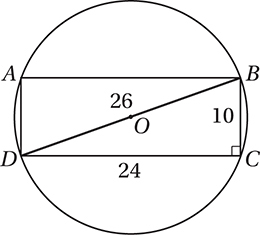
Since ABCD is a rectangle, we can find the length of its diagonal using the Pythagorean Theorem: 102 + 242 = d2. Even better, we can notice that the two legs are in a 5:12 ratio, and therefore triangle BCD is a 5-12-13 triangle. In either case, we find that DB = 26. Since DB is also a diameter of the circle, the radius of the circle is 26/2 = 13, and therefore, the area of the circle is πr2 = π(13)2 = 169π.
13. B
Problem Solving/Data Analysis (enumeration of data) MEDIUM
If Niko is the 8th oldest person in the class, then there are 7 students older than he is. If he is the 12th youngest person, then there are 11 students younger than he is. Therefore, there are 18 students in addition to him, for a total of 19 students.
14. D
Additional Topics (complex numbers) MEDIUM

15. B
Advanced Mathematics (exponentials) MEDIUM
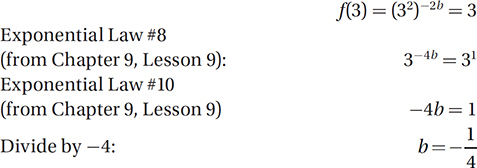
16. A
Data Analysis (probability) MEDIUM
Since the sum of 55 and 35 is 90, which is 10 greater than 80, there must be at least 10 in the overlap between the two sets. Statement (B) is not necessarily true, because it is possible that all 35 students taking AP courses are also varsity athletes, which is more than half of 55. Statement (C) is not true because 80 – 55 = 25 students do not play varsity sports, and 80 – 35 = 45 students do not take at least one AP course. Statement (D) is not necessarily true, because 35 students take at least one AP course and 25 students do not play a varsity sport, and this sum, 35 + 25 = 60, is less than the total number of students, so it is possible that there is no overlap between these two sets.
17. A
Algebra (slopes) MEDIUM
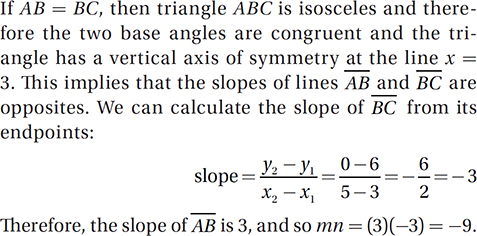
18. D
Advanced Mathematics (functions) MEDIUM-HARD
To answer this question, we must evaluate each of the three functions for an input of ½:
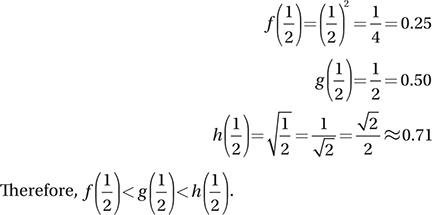
19. A
Data Analysis (graphing data) MEDIUM-HARD
If y varies inversely as the square of x, then the variables
are related by the equation  , where k is a positive constant. The graph of such an equation in the xy-plane looks like this:
, where k is a positive constant. The graph of such an equation in the xy-plane looks like this:
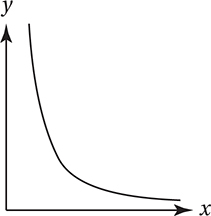
This most closely resembles the scatterplot in choice (A).
20. C
Algebra (expressing relationships) MEDIUM-HARD
The portion of the birds that are finches is just the number of finches divided by the total number of birds. Since there are already 30 finches, adding n finches makes 30 + n finches. Since there are already 12 + 30 + 18 = 60 total birds, adding n finches makes 60 + n total birds.
Since 80% = 4/5,  .
.
21. B
Advanced Mathematics (functions) MEDIUM-HARD
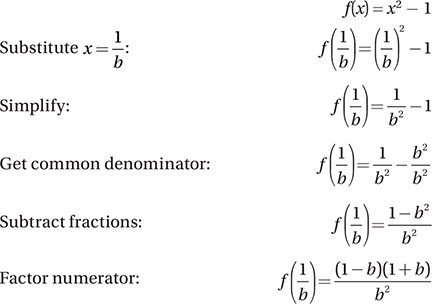
22. D
Advanced Mathematics (quadratics) MEDIUM-HARD
Since k can be any number greater than 0, let’s pick k = 1 for convenience. If x = 3, then y = (1)(3)2 = 9, and if x = 12, then y = (1)(12)2 = 144. In this case, both statement (B) and statement (D) are true, since 9 + 135 = 144 and 9(16) = 144; therefore, we can eliminate choices (A) and (C). Now let’s choose k = 2. If x = 3, then y = (2)(3)2 = 18, and if x = 12, then y = 2(12)2 = 288. Since 18 + 135 ≠ 288, but 18(16) = 288, the correct answer is (D).
Notice, also, that since y varies directly as the square of x, then when x is multiplied by n, y is multiplied by n2. Since x is being multiplied by 4 (to go from 3 to 12), then y must be multiplied by 42 = 16.
23. B
Advanced Mathematics (analyzing quadratics) HARD
One way to tackle this question is simply to simplify the expression for f(7), and then see which choice gives the same expression.
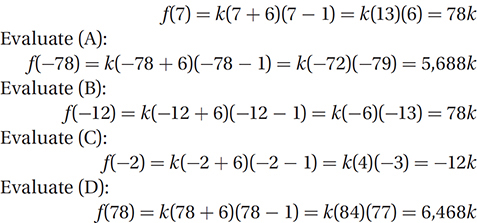
This shows that f(–12) is equal to f(7). Alternately, you might just make a quick sketch of the parabola and take advantage of the symmetry:
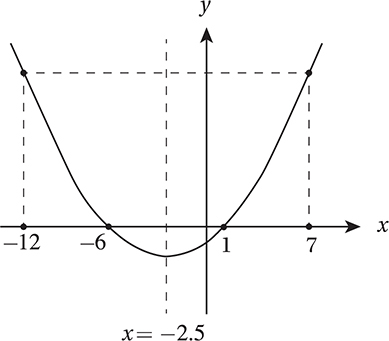
24. C
Problem Solving (percentages) MEDIUM-HARD
Let p = the initial price per share of the stock. After the first year, its price increased by 20%, so its price was (1.20)p. After the second year, this price declined 25%, so its price was (0.75)(1.20)p. After the second year, this price increased by 10% so its price was (1.10)(0.75)(1.20)p = 0.99p, which means that overall the price decreased by 1%.
25. D
Algebra (exponentials) MEDIUM-HARD
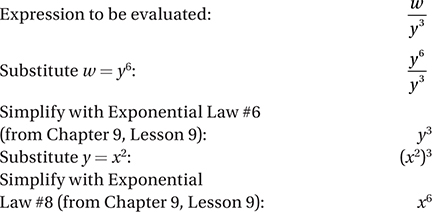
26. D
Data Analysis (tables) MEDIUM-HARD
Although we don’t need to fill in the entire table, it’s interesting to note that it has a “diagonal symmetry” when it is completed. Just following the rule and moving systematically toward x reveals that it is 56 + 56 = 112.
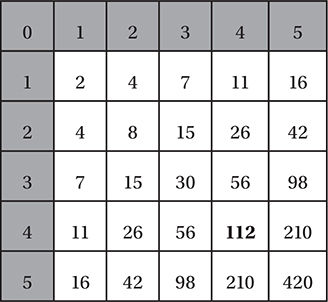
27. C
Advanced Mathematics (quadratics) HARD
We can find the value of c by just substituting x = –1 into the equation.
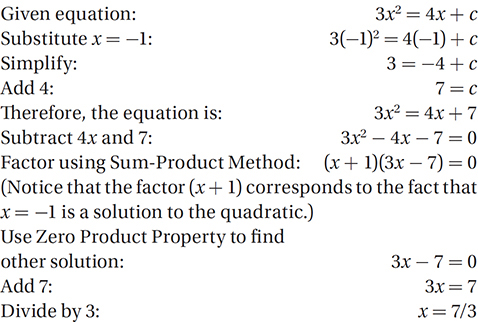
28. B
Special Topics (arcs) HARD
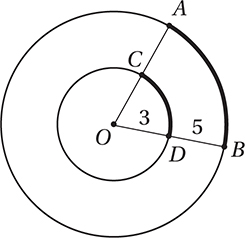
First, we should make sure we mark up the diagram with the measurements we know: OD = 3 and DB = 5. This means that the radius of the small circle is 3 and the radius of the large circle is 8. Notice that sectors AOB and COD share a central angle, and therefore are similar. So the measures of arc CD and arc AB are
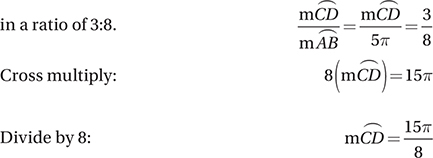
29. C
Data Analysis (graphs) MEDIUM
Since there are only four data points, it’s not hard to list the February-May ordered pairs. Notice that the February axis is vertical, and the May axis is horizontal, so the typical x-y relationship is reversed:
Class A: February: 60, May: 60
Class B: February: 80, May: 70
Class C: February: 50, May: 70
Class D: February: 90, May: 90
Notice that the only class that saw an increase in percent participation is Class C.
30. C
Data Analysis (graphs) HARD
We just need to tally the number of students who participated from each class.
Class A: 60% of 20 students = 12 students
Class B: 70% of 30 students = 21 students
Class C: 70% of 20 students = 14 students
Class D: 90% of 30 students = 27 students
12 + 21 + 14 + 27 = 74 students
31. 0.8 or 4/5
Algebra (radical equations) EASY

32. 8
Advance Mathematics (quadratics) EASY

33. .96
Additional Topics (circles/triangles) MEDIUM-HARD
When looking for the area of the triangle, remember that there are two basic methods: the direct method and the indirect method. With the direct method, we simply plug the base and height measurements into the formula  , and with the indirect method, we find the area as the sum or difference of other areas. In this case, since we know the lengths of one of the sides, the direct method is probably best. But we will need to find the height as well.
, and with the indirect method, we find the area as the sum or difference of other areas. In this case, since we know the lengths of one of the sides, the direct method is probably best. But we will need to find the height as well.

Now let’s mark up the diagram with this information. Since the radius of the circle is 1, the diameter FH has a length of 2. Now we can use the Pythagorean Theorem to find the length of GH, which is the height of the triangle

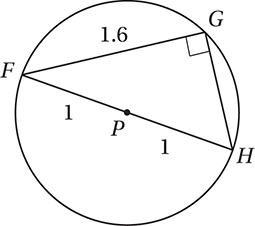
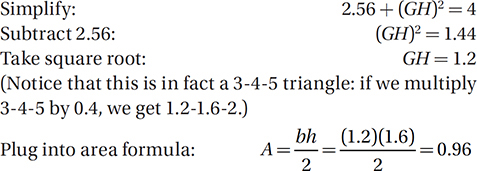
34. 4.29 ≤ x ≤ 4.79
Algebra (solving inequalities) HARD
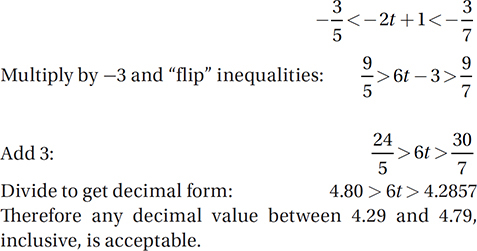
35. .84
Advanced Mathematics (trigonometry) MEDIUM-HARD
You may find it helpful to make a quick sketch of the unit circle on the xy-plane, as we discussed in Chapter 10. Subtracting π radians (or 180°) from an angle just means rotating the terminal ray of that angle 180° clockwise. It should be clear, then, that in the xy-plane, the angle with measure x – π points in the opposite direction of the angle with measure x. Recall that the cosine of an angle is just the x-coordinate of the point where its terminal ray intersects the unit circle. Since cos (x – π) = 0.4 (that is, its cosine is positive), its terminal ray must be in a quadrant where the x-coordinates are positive: either quadrant I or quadrant IV. Let’s just put it in quadrant I. This means that the angle with measure x is in quadrant III, and so it has the opposite cosine:
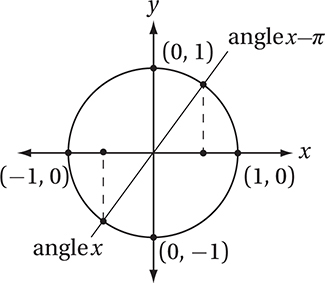

36. 12
Problem Solving/Data Analysis (word problem) MEDIUM-HARD
This one is a bit trickier than it looks. We have 10 pounds of grain and have used it to feed 20 chickens. Since one pound of grain feeds 5 chickens, proportionally we need 4 pounds of grain to feed 20 chickens. This leaves us 10 – 4 = 6 pounds of grain to feed the pigs. Since 1 pound of grain can feed 2 pigs, proportionally 6 pounds of grain can feed 12 pigs.
37. 371
Problem Solving (extended thinking) HARD
The total revenue from the tickets sold is $60(50) + $50(60) + $40x + $35y + $30(100). If the total revenue was $15,000, then 3,000 + 3,000 + 40x + 35x + 3,000 = 15,000
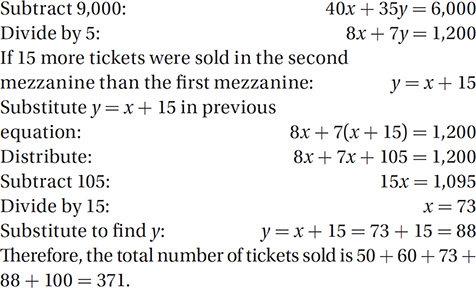
38. 25
Problem Solving (extended thinking) HARD
The mathematical model  has embedded in it the predicted revenue per section: np = revenue per section = $2,800. Notice that this prediction is $200 less than the actual average revenue per section of $3,000, so clearly the model underestimated the number of tickets sold per section.
has embedded in it the predicted revenue per section: np = revenue per section = $2,800. Notice that this prediction is $200 less than the actual average revenue per section of $3,000, so clearly the model underestimated the number of tickets sold per section.
If we want to analyze this situation in detail, we can compare the predicted tickets sold to the actual tickets sold by adding a new column to the table entitled “predicted sold,” which we can fill in using the calculations from our model. Also, it might be helpful to also add columns for “total revenue” for each situation.
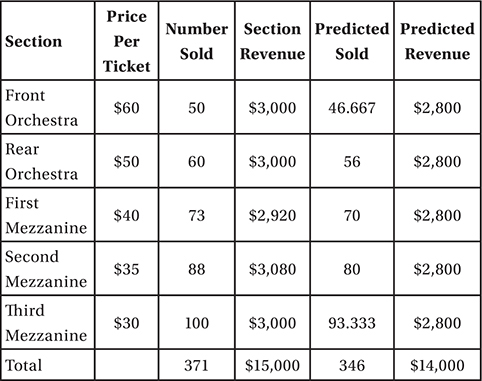
You might notice that the predicted number of tickets sold in the Front Orchestra and the Third Mezzanine are fractions, which seems strange. (Of course we can’t sell a fraction of a ticket!) But even if we round these predictions to the nearest whole numbers, 47 and 93, the total number of tickets is the same: 346, which underestimates the number of tickets sold by 25.
Section 5: Essay
Sample Essay: Analysis of Ellis Parker Butler’s “On Spelling”
In his essay “On Spelling,” Ellis Parker Butler argues that we should change the rules of English spelling to make them more logical. He says that the rules of spelling have “nothing to do with genius, except to kill it” (1). The essay is consistently humorous, and he uses first-person anecdote, anthropomorphism, and cultural allusions to drive his points home. He also provides two alternatives to our current system of spelling, but they are not meant to be taken seriously, but show the silliness of the rules themselves.
Butler’s tone is comical throughout the essay. In the first paragraph, his essay (written in 1906) claims that America at the turn of the 20th century was lagging behind Europe because it was “the slave of the spelling-book” (1), and that writers like him, who “simply blaze with genius” (2), shouldn’t have to write “a stupid sort of literature that is spelled correctly” (2). He is kidding when he says that “we take to being killed by the automobile quite naturally now” (3), but he is using humor to make the point that Americans can get used to even stupid and dangerous things given enough time. He also pokes fun at the hopes for real change when he says that the advantage of his plan is “so manifest that I am afraid it will never be adopted” (7).
He uses first-person anecdote in the essay, as if the argument is a discussion between his wife, Serena, and himself. He says that “Serena and I will form a society for the reforming of English pronunciation” (6), and he even makes a joke that his bad spelling had something to do with his “ardent love” (8) for his wife. Although this casual tone and style does differs from that of a real spelling expert, it provides charm to the essay.
Butler also uses anthropomorphism to describe his ideas about spelling, which helps to make his explanation come to life for readers. He talks about the word “although” as if it were a person: “‘Altho’ does all the work, and ‘ugh’ sits on the fence and whittles. I would put ‘ugh’ to work (5).” This shows that his plan for reforming English spelling would appeal to the American value of hard work.
Butler makes many cultural allusions about American thinking. He says that Americans are slow to change (“we Americans do not like sudden changes” (3)) hard working (‘we want no idle class in America” (4)) and practical (“Serena’s plan is … more American … she would simply boycott them” (8)). In this way, Butler is trying to connect with his readers in terms that make sense to them and their values, and so they are more likely to approve of his plan.
This essay is not written from the point of view of an intellectual or expert, but from an ordinary American who doesn’t like dealing with dumb rules. By using a humorous style in the first person, and by using anthropomorphism and cultural allusions, he makes his essay easy and fun to read even as it makes its points.
Scoring
Reading—4 out of 4
This essay demonstrates a strong comprehension of Butler’s central claims, using summary, paraphrase, and quotations. It summarizes Butler’s central thesis (we should change the rules of English spelling to make them more logical), significant rhetorical elements (first-person anecdote, anthropomorphism, and cultural allusions), and tone (consistently humorous). The quotations are carefully chosen to illustrate the central elements of Butler’s essay, and are accompanied by relevant and accurate commentary.
Analysis—4 out of 4
This essay shows a strong and critical analysis of Butler’s argument and style. The elements it identifies (humor … first-person anecdote, anthropomorphism, and cultural allusions) are well-chosen, and he discusses the effect of each element (e.g. he is using humor to make the point that Americans can get used to even stupid and dangerous things; … his casual tone … provides charm to the essay; … anthropomorphism … helps to make his explanation come to life … [and] shows that his plan for reforming English spelling would appeal to the American value of hard work; … cultural allusions … connect with his readers in terms that make sense to them and their values), without taking a side for or against Butler’s thesis. It also provides substantial textual evidence for its claims, and demonstrates a strong understanding of Butler’s rhetorical task.
Writing—4 out of 4
This essay shows a strong mastery of language, organization, and sentence structure. It remains focused on a clear central claim, and develops its secondary claims in well-organized paragraphs. It demonstrates effective variation in sentence structure and strong verb choice (e.g. drive his points home … pokes fun at the hopes for real change). Largely free from grammatical error, this essay demonstrates strong command of language and proficiency in writing.